






TWO days of interactive debates... EIGHT hours of dedicated networking... ONE place to be








TWO days of interactive debates... EIGHT hours of dedicated networking... ONE place to be
The European Light Rail Congress brings together key decision makers and leading professionals from across Europe for two days of debate covering the role of technology in the development of sustainable urban travel.
With presentations and exhibitions from some of the industry’s most innovative suppliers and service providers, this congress also includes a technical visit and over eight hours of networking sessions.
For 2024 we are taking the congress to the beautiful Spanish city of Seville, home of the Metro de Sevilla system. Both metro and trams run throughout the city providing modern and efficient public transport, with safety and the environment being key factors which contribute to improving the quality of life of the citizens of Seville and the surrounding areas.
The event will be held at the Hotel Melia Lebreros, which provides a superb conference centre that offers everything under one roof for everyone to enjoy. We will be working with our partners once again to offer a superb behind-the-scenes depot visit for delegates; and have also arranged an evening reception with some fantastic food and drinks to allow for maximum networking opportunities.
ORGANISED BY SUPPORTED BY
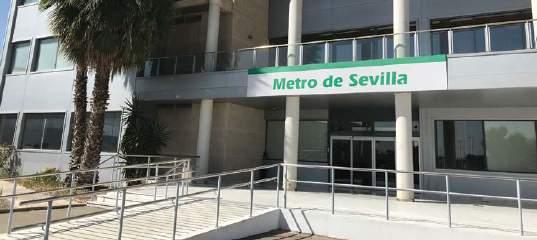




NEWS 452
Prague extension opens; New CAF orders for Rome; Nexus expects a difficult winter.
gl RA REPORT 456
Another year of excellence is celebrated at this year’s Global Light Rail Awards.
MA i NSPR i Ng / DATA REPORT 466
Jacinta Barnicoat asks if Liverpool can prove the case for reviving Merseytram.
l A RE gi ONA l CONNECTOR 468
With the opening of the Regional Connector and Crenshaw Line, LA now has the largest light rail system in the US – but more is to come...
F i VE y EARS OF TRAM -TRA i N 471
Dr Rob Carroll and Simon Coulthard review the first five years of the Sheffield Tram-train pilot – and look to the next five years.


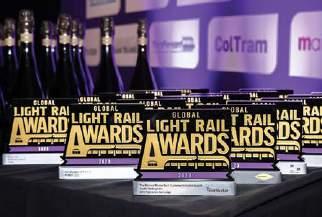
FRE i Bu Rg i M BRE i S gAu 475
Andrew Thompson reports from an expanding system near the Black Forest.
EMBRAC i N g D igi TA l BENEF i TS 479
Andrew Willetts explores how digital technology and AI can be used to drive efficiencies across public transport.
Sy STEMS FACTF il E : K u STTRAM 482
Neil Pulling explores Belgium’s coastal tramway, often cited as the world’s longest.
WOR l DW i DE REV i EW 487
Extensions for Genoa; Test running in Seoul.
MA il BOx 491
Was Tyne and Wear metro a mould-breaker?
C l ASS i C TRAMS 492
Mike Russell reports on a small museum in Aberdeen and remembers Lubomir Kysela.
You can’t turn the pages of any transport publication – including, indeed, this one – without being told by a government, operator or manufacturer somewhere just how hard they are working to hit Net Zero targets. In some countries, this legally has to be achieved by 2050.
What exactly does Net Zero mean? The long-winded definition, according to the textbooks, is “a target of completely negating the amount of greenhouse gases produced by human activity, to be achieved by reducing emissions and implementing methods of absorbing carbon dioxide from the atmosphere.”
The trouble is, this seems to go completely over the heads of a vast percentage of the human race. These are exactly the people we are trying to persuade to give up their cars and ride on eco-friendly trams, trains and buses.
A recent joint survey by the UK’s Institution of Civil Engineers (ICE) and All-Party Parliamentary Group (APPG) on Infrastructure reveals that 46% of people say they find it difficult to use public transport more because the barriers are too high. They say they can’t afford the fare, don’t like purchasing tickets on their phones, live outside town, suffer from illness and disabilities, and so on. If the answer is buying an electric car, 56% admit they don’t know how to switch one on, let alone plug it into the mains supply.
the official journal of the light rail transit Association

DECEMBER 2023 Vol. 86 No. 1032
www.tautonline.com
EDITORIAL
Editor – Matt Johnston matt@mainspring.co.uk
Associ At E Editor – Tony Streeter tony.streeter@mainspring.co.uk
WorldW id E Editor – Michael Taplin miketap@mainspring.co.uk
N EW s Editor – John Symons johnsymons@mainspring.co.uk
sEN ior c o N tributor s –Howard Johnston , Neil Pulling
WO rldW id E C ONT ribu TO r S
r ichard Felski, Andrew Grahl, Andrew Moglestue, Paul Nicholson, Herbert Pence, Mike russell, Nikolai s emyonov, Alain s enut, Vic simons, Andrew t hompson, Witold urbanowicz, bill Vigrass, Francis Wagner, t homas Wagner, Philip Webb. Productio N – l anna Blyth
tel: +44 (0)1733 367604 production@mainspring.co.uk
d E si GN – Debbie Nolan
A Dv ERTI s I ng
co MME rci A l M ANAGE r – g eoff Butler tel: +44 (0)1733 367610 geoff@mainspring.co.uk
Tramways & Urban Transit 13 o rton Enterprise centre, b akewell road, Peterborough PE2 6X u, u K
Tramways & Urban Transit is published by Mainspring on behalf of the lrtA on the third Friday of each month preceding the cover date.
l RTA MEMBERSH i P (with TAuT subscription)
Tramways & Urban Transit is sent free to all paid-up members of the l ight r ail t ransit Association.
lrtA WE bsit E AN d di A rY Tim Kendell webmaster@lrta.org meetings@lrta.org
sU bsc RI p TIO ns, MEM b ER s HI p A n D b Ack I ss UE s lrtA Membership s ecretary ( d ept t06), 38 Wolseley road, s ale M33 7Au, u K. tel: +44 (0)117 951 7785 membership@lrta.org Website: www.lrta.org
f OR c OR p ORATE sU bsc RI p TIO ns v I s IT www.mainspring.co.uk
l RTA RE gi STERED OFF iCE 40 Fonthill road, Hove, bN3 6H d, u K. Private company limited by guarantee, No. 5072319 in England and Wales.
lrtA cHA ir MAN – Paul Rowen chair@lrta.org
© lrtA 2023
Articles are submitted on the understanding they may also be used on our websites or in other media. A contribution is accepted on the basis that its author is responsible for the opinions expressed in it, and such opinions are not those of the LRTA or Mainspring. All rights reserved. No part of this magazine may be reproduced or transmitted in any form by any means, electronic or mechanical, including photocopying, recording or by any information storage and retrieval system, without prior permission in writing from the copyright owner. Multiple copying of the contents of the magazine without prior written approval is not permitted.
PR i NT
Matt Johnston, EditorIn the face of the obvious economic issue of the loss of fuel tax revenue (and many others), all governments worldwide must be called to account to explain by consensus how they can make Net Zero affordable by providing incentives for us to change our ways. The clock is ticking fast. From January 2024, they have just 26 years to get their act together, and that’s actually not very long.
t he Manson Group l imited, st Albans, Herts A l 3 6PZ
Di STR i Bu T iON Warners (Midlands), b ourne, l incs PE10 9PH, u K
India’s RapidX
a ‘vision of the future’
India’s Prime Minister has called Delhi’s new high speed commuter railway a “vision of the future”.
Narendra Modi inaugurated services on the 17km (10.5-mile) 25kv AC Sahibadabad – Duhai railway, branded RapidX, on 20 October. Revenue-earning services commenced the following day.
The full 82km (51-mile) line between Delhi and Meerut should open throughout in 2025. However, The Hindu newspaper has questioned opening this section first because it does not connect major parts of the National Capital Region.
RapidX has an interchange with the Red metro line at Ghaziabad. The operator is Deutsche Bahn International and trains came from Alstom.
Luxembourg’s tramway will further expanded
The Luxembourg capital’s first second-generation tramline is to be completed in 2024 – but will now be expanded further.
The first phase opened in 2017 and operations along the full 16km (ten-mile) route to Cloche d’Or should commence next spring.
However, on 13 September, it was confirmed that the line will be extended south by 19km (11.8 miles) from Cloche d’Or to reach Belvaux Mairie in Eschsur-Alzette. This will open in stages between 2028 and 2035.
A fleet of 24 new trams will be needed. The project is estimated to cost in the region of EUR960m.
Siemens delivery heralds Portland LRV changes Changes are afoot for operator TriMet’s LRV fleet in the US city of Portland.
LRV 215, the prototype for Type 2 mid-life overhaul, returned to Oregon from Siemens’ plant in Sacramento in mid-October, after more than four years.
Along with the COVID pandemic and supply-chain issues, it is understood that disagreement between TriMet and Siemens over certain aspects of the work also caused delays.
Meanwhile, the first of 12 new Siemens Type 6s (Siemens S700s) had been received by 8 October. Type 6 605 was unveiled at a public ‘preview’ event on 15 October. The first Type 6s should enter service by the end of 2023.
TriMet has contracted a local recycling company to scrap the Type 1 LRVs, built by Bombardier in 1986. Car 102 was sent for scrap on 16 October. One Type 1 will be donated to the Oregon Electric Railway Historical Society for the Brooks museum.
Finland’s Prime Minister Petteri Orpo opened the 24.5km (15-mile) Jokeri Light Rail on 21 October. It has replaced Helsinki’s busiest bus route (550), which carried 40 000 passengers a day; the new light rail system has been designed to carry more than 90 000 passengers a day by 2030. It forms part of the city’s goal to steer population growth towards sustainable public transport (see also TAUT 1029).
Originally intended to open in 2021, the orbital tramway runs from Itäkekus (metro interchange) to Keilaniemi in Espoo (another metro
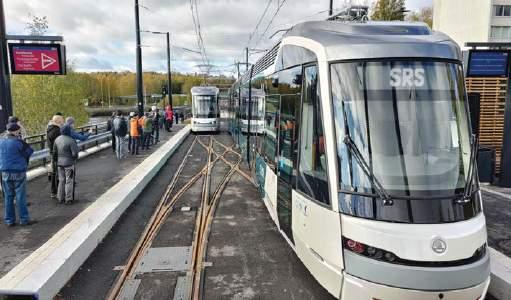
interchange), with interchange to suburban rail lines at Oulunklän and Huopalahden. All but 3.9km (2.4 miles) is on reserved track.
The whole project has cost EUR382m – some EUR13m under budget – and it has opened a year ahead of schedule. A new EUR69.5m depot has been built at Roihupelto. As with the rest of Helsinki’s ten line, 45km (28-mile) tramway system, the JLR is metre-gauge. However, there is no connection to the rest of the network.
There are 34 low-platform stops, to be served by a fleet of 29 Škoda Transtech Artic X54
GPP, the operator of the tramway in the Croatian city of Osijek, has ordered ten low-floor cars from Koncar Elektricna Vozila in a deal worth EUR25m. The first should be delivered in March-September 2025, and there is an option for 20 more.
The new trams will be similar to the 20.8m three-section TMK 2300 that Koncar is building for the Croatian capital, Zagreb. They have space for 135 passengers (35 seated). If 30
trams are delivered, the contract value will be EUR55.35m. The only other bidder for the contract was Polish manufacturer PESA. Services on Osijek’s tram system, which dates from 1884 and was electrified in 1926, are currently suspended to permit reconstruction of the infrastructure. Work on this EUR30m project is being carried out by a consortium led by the Koncar group. Operation is due to resume in August 2024.

low-floor trams (601-29), which have an average speed of 25km/h (15.5mph). The 34.5m doubleended five-section cars are 2.4m wide and can carry up to 214 passengers (78 seated). They are built so that additional sections can be added to produce a 44m tram if traffic growth requires.
The initial operator will be HKL (Helsinki City Transport), but operation could be contracted out at a later stage. There will be a 12-minute service at peak times, although this could be increased to six minutes when the whole fleet is delivered. The end-to-end journey time is 65 minutes.
MPK, the tram and bus operator in the Polish city of Poznan, has started trials with a prototype 100% low-floor 16m bogie tram from Modertrans. The Moderus Gamma LF05AC is the first single unit tram to be built in Poland with a low floor throughout.
Car 600 has an innovative drive system using silicon carbide transistors for greater energy saving, smoothness of driving and almost completely silent operation. The bogies are about 15% lighter than previous examples and are equipped with smaller asynchronous motors. An electro-mechanical parking brake is installed, so there is no oil waste.
Regenerative braking is another energy-saving feature, with super-capacitors to store energy. These permit 2km (1.24 miles) of operation away from overhead wires. The tram is fully air-conditioned using carbon dioxide for cooling and there is the option of reversing the air conditioner to create a heat pump for winter operation.
The French city of Brest has offered residents the chance to invest in its second tram line as well as a high-performance bus line. Residents can commit as little as EUR1 (up to a maximum of EUR5000) over five years (with a 4% rate of interest) in order to raise EUR1m. This will go towards the projected EUR220m cost of both projects.
Construction of the second tramline started in April 2023. The 5.3km (3.3-mile) route links Gare Gambetta to Hôpital Cavale. It is due to open in 2026. The EUR130m project also includes ten new Alstom trams. Work has also started on a 4.8km (three-mile), EUR90m high-performance bus route to Lambézellec.
Fundraising started on 27 September and runs until 25 December. Yann Guével, VicePresident of Brest Métropole, said: “Citizen funding at this
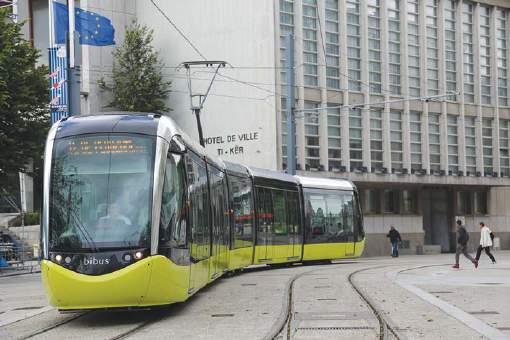
level has never been done before, it’s a first.
“The logic of citizen investment is, above all, a way of making the residents actors in energy transition, by placing their savings in a project
where their funds are directly invested locally.”
Brest opened its EUR383m, 14.3km (8.9-mile) tramway in June 2012. Its 20 Alstom Citadis trams carry 10.5m passengers a year.
The smallest tram network in the Czech Republic opened a new depot on 21 September.
The depot’s main building at Jeremenkova, in the city of Olomouc, is 105m long and its three roads can accommodate nine coupled sets of single bogie cars. Light maintenance work can also be carried out on site.
The new depot became necessary to accommodate the increased fleet that network extensions have demanded. It cost more than CZK300m (EUR12m) to build, with 85% of the funds provided by the EU. Public transport operator DPMO published a tender in the summer for nine more
A 9.9km (six-mile) suspended monorail opened in the southeastern suburbs of the Chinese city of Wuhan on 26 September.
The automated monorail links Jiufengshan and Longquanshan. It features interchanges with Metro Line 11 at Gaoxin Boulevard and with the Guanggu tramway Line 2 at Gaoxin 2nd Road. There are six stations along the ‘ecological corridor that serves optical and electronics industries’. However, as the cars have a glass floor, some suggest that the line is aimed as a tourist attraction.
The 24m-long, 2.5m-wide twosection Photon Skyrail cars were built by CRRC Qingdao Sifang. Each carries up to 200 passengers and runs at up to 70km/h (43mph). The cars have supercapacitors to permit self-traction in the event of a power failure.
The monorail offers service every ten minutes 08.00-20.00; the peak headway is six minutes.
Authorised in 2020, the line had been hoped to open in 2021 – but the COVID pandemic caused delays. It is planned to extend the line to 26.7km (16.6 miles).
Ilévia, the transport provider in France’s greater Lille area, has ordered 24 32m metre-gauge Citadis trams from Alstom (with an option for six more). If all 30 are ordered, the contract value will be EUR124.8m.
The trams, due to be delivered in 2026-27, will replace the 24 Breda low-floor trams purchased when the Mongy interurban lines to Roubaix and Tourcoing were rebuilt in 1993-94. The new trams will be larger (five section rather than four), offering a 20% increase in capacity, with 60 000 daily riders predicted for 2034. These will be the first metre-gauge Citadis trams that Alstom has built.
Greek metro operator announced A Franco-Italian consortium has won the EUR250m contract to operate the new Thessaloniki Metro, which is due to open in 2024. ATM, the metro operator in Milano (Milan) and French consultant Egis will operate the 14.4km (8.9-mile) automated line for the next 11 years.
16m bogie cars with 25% lowfloor access. Its fleet currently comprises 69 trams, including 18 modernised Tatra T3s.
Olomouc’s standard gauge tramway opened in April 1899 and now operates seven lines over 15km (nine miles).
A new 2.6km (1.6-mile) line to Nové Sady opened in 2022.

ABOVE: Vario LF single cars 246+241 pass the new Olomouc tram depot on 13 October while running on an inbound Line 4 service. A. Thompson
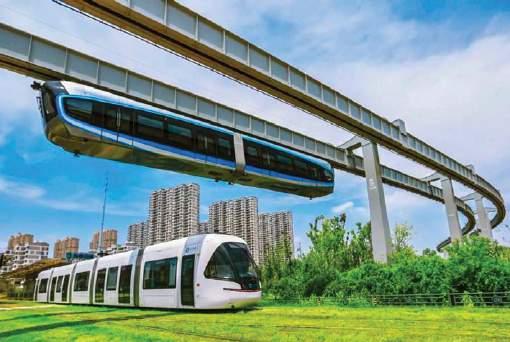 ABOVE: A Brest tram passes the town hall over pointwork already installed for the second line. M. Briand
ABOVE: The new monorail crosses over the Wuhan tram line. Optics Valley Skytrain
ABOVE: A Brest tram passes the town hall over pointwork already installed for the second line. M. Briand
ABOVE: The new monorail crosses over the Wuhan tram line. Optics Valley Skytrain
Roma (Rome) tramway operator ATAC has ordered 40 new five-section double-ended trams from CAF – but the contract could be increased to a total of 121, worth EUR457m. Delivery should start in 2025 and they are likely to replace the 40 Stanga Urbinati articulated cars, which date from the 1940s.
The new trams will be 33.5m long with space for 215 passengers (68 seated) and will be air-conditioned. Traction batteries will permit running away from the overhead wire.
Eugenio Patane, Roma’s Councillor for Mobility, said: “This is an historic moment because, after almost 20 years, the administration is investing in buying new trams to serve new and existing lines, using the most innovative technology for more capacity and better performance.”
CAF has already supplied metro trains to Roma.
The Italian capital’s 31km (19-mile) tram requires 70 trams a day for its six lines. Four new lines are also in the early stages of planning.
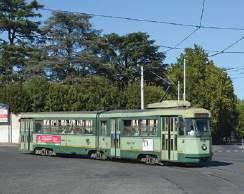
The German Public Transport Operators Association (VDVA) has submitted a report to the Federal Government identifying 451km (280 miles) of U-Bahn lines and 6320km (3927 miles) of tramway and light rail (Stadtbahn) needing EUR64bn by the end of the decade to keep them in good condition. The report also highlighted that an additional EUR4.5bn is required to expand systems to cope with rising traffic levels.
The federal programme for investment in public transport (GVFG) amounted to EUR902m in 2022, but the number of projects bidding for funding has increased fourfold. The VDVA paper has joined a report from the German Automobile Club (ADAC) that says EUR283bn
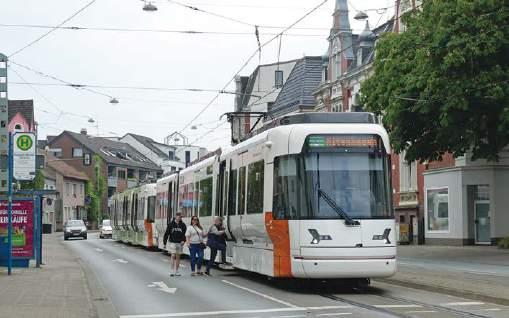
will need to be invested in 714 000km (440 000 miles) of roads in the same period. This is at a time when the public deficit
increased by 6.4% (EUR127.3bn) in 2022 and borrowing increased to EUR42.1bn in the first half of 2023.
The Czech capital Praha (Prague) has opened two extensions to its tram network in quick succession.
The 500m one-stop extension from Holyně to Slivenec opened on 13 October. The new alignment features a steep 5.3% gradient while an expansive, three-track turning loop has been built at Slivenec terminus. This is large enough to allow more than ten 30m trams to wait
Timescales will change: that’s what Nexus’ former Managing Director Martin Kearney warned delegates at the UK Light Rail Conference back in June about the introduction of the new Stadler Class 555s
This prophecy has come true and the first of the 46 new EMUs should now enter service in 2024 rather than December 2023. This has left the Tyne and Wear Metro’s operator warning passengers of a “difficult winter” as it fights to keep the original Metrocar EMUs running.
The new Class 555s passed a milestone in September by
successfully passing a ‘crush test’. This involved loading a Class 555 with containers of sand, weighing 39 tonnes, in order to simulate a full load of passengers. The loaded unit undertook night runs across the network to check that the braking systems could cope with such a load while the unit’s behaviour on curves was also assessed.
Michael Richardson, Nexus’ Head of Fleet and Depot Replacement Programme, said: “Crush load testing is a critical part of getting the first new Metro trains ready for our customers.
there. Lines 4 and 5 as well as the night line 94 now terminate at Slivenec, which serves a large housing development.
Then, on 23 October, the 2.3km (1.4-mile) extension from Divoká Šarká to D ě dina opened. Lines 20 and 26 now serve another new housing development at Na Dě dina.
A full report into Praha’s public transport system will appear in the next TAUT
“Testing the new Metro fleet is a really detailed process. We are going through around 90 000 different checks and are leaving no stone unturned as we get the first train ready to welcome customers next year.”
A 2024 launch for the Class 555s means that Metro engineers will have to nurse the original Metrocars – the youngest of which is 42 years old –through another winter. Nexus Communications Officer David Punton told the BBC that the old trains are “temperamental” in cold weather and that it could be a “difficult winter”. Only 63 of the original 90 sets have been in service in recent weeks.

Two cars have been earmarked for preservation while the rest are likely to go for scrap.
Nexus has abandoned the idea of giving away redundant Metrocars to community groups due to costs.
Nexus Customer Services
Director Huw Lewis said:
“We recognise that there is affection for the trains, but the project is not viable, or good use of public money. This is due to the complexity of delivery arrangements and the need, in many cases, for cranes and extra heavy machinery or significant works to prepare sites for accepting the trains.”
Light rail systems around the UK could benefit from the GBP36bn (EUR41.2bn) that the UK Government has pledged to spend on transport schemes in the wake of cancelling the northern leg of the High Speed 2 railway. UK Prime Minister Rishi Sunak announced on 4 October that the controversial line will no longer be built beyond Birmingham to reach Manchester.
In its wake will come ‘Network North’, which involves dividing the estimated ‘northern leg’ budget to projects across the country. The Network North White Paper, published the same day, included funding West Yorkshire Combined Authority’s proposed mass transit system from Leeds to Bradford, Garforth and Dewsbury (TAUT 1029).
The White Paper also said funding might be available for extending Manchester Metrolink to Heywood, Bolton, Wigan and Terminal 2 of Manchester
Airport, as well as extensions to the Sheffield Supertram network. It also listed new trams for Blackpool.
Also included is GBP1.5bn towards the creation of an East Midlands City Region, complete with a Metro Mayor whose role would be to deliver “Londonstyle public transport networks in Nottinghamshire and Derbyshire”.
This could include extending the Nottingham Tram network to Gedling and south from Clifton South terminal.
While cancelling HS2 beyond Birmingham was condemned by rail experts and commentators, the Network North paper also drew criticism after a first draft included re-opening the Leamside line, an aspiration of Tyne & Wear Metro, that was not included in subsequent drafts. It also suggested that Manchester Metrolink could be extended to Manchester Airport; this had to be clarified to Terminal 2 as the original link opened in 2014.
When Transport for London (TfL) invests in new projects, the rest of the UK benefits: that’s the conclusion of a new report produced by global project management company Hatch.
The report states that TfL investment in everything from new rolling stock and electric buses to new signs contributes GBP5.9bn (EUR6.7bn) to the UK economy and supports over 100 000 jobs across the country.
In 2022-23 alone, TfL invested GBP6.5bn (EUR7.4bn) with a total of 2072 suppliers, of which 93% were based in the UK and 49% were small-to-medium business enterprises. Some two-thirds of its suppliers are outside London and as far away as Fleetwood in Lancashire and Falkirk in Scotland’s Central Lowlands. It also highlighted Siemens’ new factory in Goole (Yorkshire) where new Piccadilly Line trains are being built.
London’s Transport Commissioner Andy Lord said:
“This new report showcases just how powerful and economically positive TfL’s supply chain is.
“The report makes clear that it is wrong to view our transport network through a Londoncentric lens. Nothing would be possible without the power and innovation of the UK industry as a whole.”
However, the report emphasised the need for TfL to be supplied with consistent funding. City Regional Sustainable Transport Settlements, the report said, have “often been termed London-style funding deals”.
However, it added: “London itself currently has no such arrangement and no funding certainty beyond the end of this financial year”.
TfL’s latest funding settlement is due to end in March 2024. It is currently negotiating with the UK Government to provide a GBP500m (EUR573m) funding package for 2024-25.
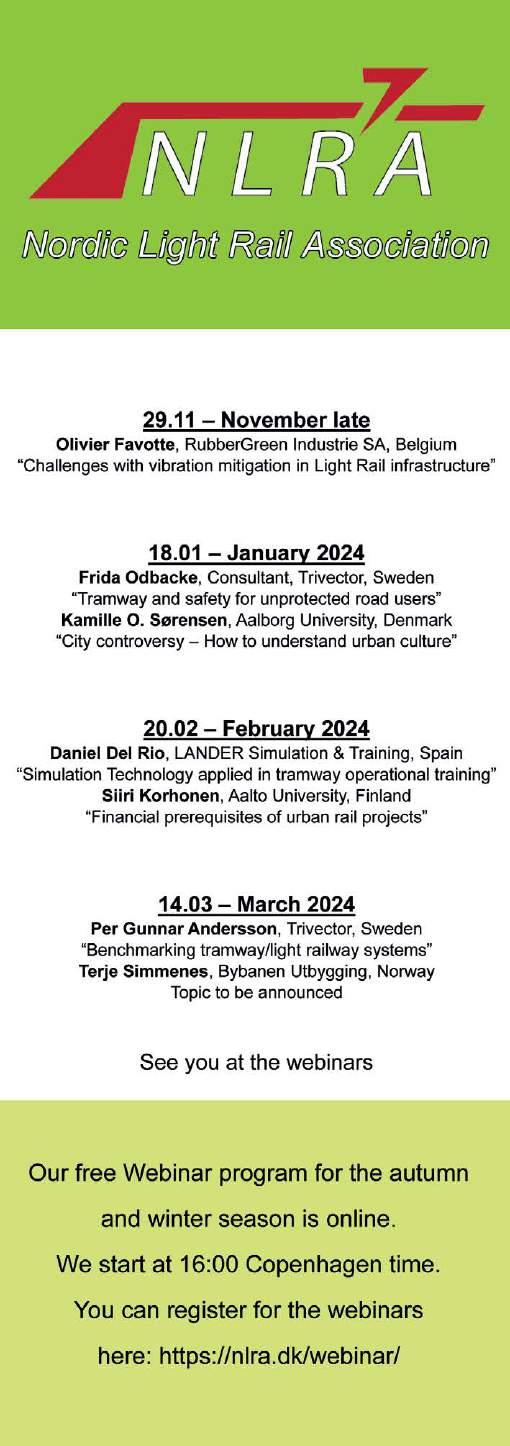


There was a record attendance – and a host of surprises – at this year’s celebration of excellence and innovation at London’s Honourable Artillery Company in October.
The World Cup, and almost 500 light rail and metro urban systems in operation… the year 2022 was certainly eventful across the world’s public transit industry. There are always successes – and challenges – that face us all, but we are certainly up to the task.
This was the opening message from Nicholas Owen, journalist, TV presenter and committed light rail advocate, returning again to welcome 280 attendees from almost every continent to the the Global Light Rail Awards (GLRA) at London’s historic Honourable Artillery Company on 4 October. There were over 110 entries, demonstrating just how prestigious the event has become.
Scorching weather and heavy floods are everyday stories, and nations are waking up to the realisation that it’s everyone’s fault. The responsibility lies with us to change the way we run our lives.
The GLRA judges chose Metro de Sevilla as the Winner in the Best Environmental and Sustainability category. They praised a star-performing Spanish green tramway that has slashed energy consumption by a third over the last decade simply by driving trams more carefully. In 2022, it went further
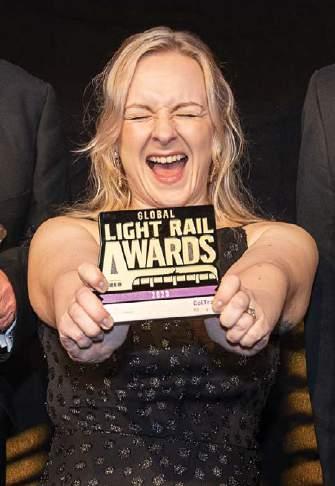

by installing 2000 solar panels on its buildings, generating two million kilowatts of energy per year, enough to power half its trams.
With its laser-like focus on ‘Net Zero’, a Highly Commended award went to Metro Málaga from the same country. Sustainability is top of the agenda in this township of just over 200 000 people, and a new extension puts a third of its population within easy reach of a tram. Ridership has more than doubled since 2019, with only two additional stations.

The Richard Brown Best Customer Initiative category was renamed as a memorial to North Star Consultancy founder Richard Brown, a long-term supporter of the Global Light Rail Awards, who we lost during the last year.
Keolis Nottingham (UK) was named Winner. As Nicholas Owen remarked: “The trouble is, passengers often don’t appreciate that we have a business to run. They try and travel without a ticket, and sometimes cause wilful damage.
The GLRA judges were impressed with Keolis’ four-month zero-tolerance campaign. Security officers held trams at stops to check passengers boarding and leaving, and over 22 000 fare evaders were caught.
Two other entries received Highly Commended awards.
The Midland Metro Alliance in the UK’s West Midlands did its best to look after passengers during construction of its latest Birmingham Eastside and Brierley Hill extensions, with communication that was praised from local businesses.
The second award went to operator West Midlands Metro from the same conurbation, which increased customer satisfaction levels from 53% to 91% in 12 months by pegging fares, using digital technology to support schools, allowing community groups to travel at a discount, and supporting others in difficulty.
The category Winner for the Significant Safety Initiative award was KeolisAmey Docklands for its use of Artificial Intelligence. The judges remarked: “It’s every tram driver’s nightmare when a bulky item is thrown onto the track, and worst of all attempts at suicide. At Custom House station in London, computerised cameras think for themselves, surveying the full length of platforms.”
On test for 12 months, they picked up false alarms, trespass, and bottle throwing, and weren’t fooled when testers used fabric dummies instead of real people.
A Highly Commended award went to West Midlands Metro for its novel ‘Trap and Drag’ door closing mechanism that reduces the risk of serious passenger casualties.
The KeolisAmey Docklands team was back on stage to receive another trophy, this time Highly Commended in the Technical Innovation of the Year (Infrastructure) category, for the London Artificial Intelligence project that has saved lives. The GLRA judges rated it again for its innovative features.
Also Highly Commended was AECOM for its research into sound absorption during the planning of a new tramline. Residents in

On top form as ever, GLRA host and light rail enthusiast Nicholas Owen entertained guests with stories of his travels around the world.

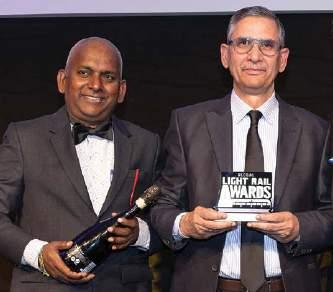
Toronto, Canada, wanted straight answers when transit operator Metrolinx proposed the Lakeshore East Joint Corridor line. Online kit called an Immersive Sound Studio received 100 000 online and mobile phone hits.
Senior staff from Keolis Hyderabad travelled nearly 8000km (5000 miles) from India to learn of their success as category Winners. The story was related how a power failure shut down the line into a major shopping centre for five days, lost millions of rupees in ticket revenue, and angered traders. An overhaul of the power system was enacted, solving failures, expensive power leaks, and a lack of power for trams at stations at the end of the line.
It was a good night for Škoda Group from Helsinki, Finland, a newcomer to the GLRA. The Winner in the Technical Innovation of the Year (Rolling Stock) category has gone back to the drawing board with its Forcity Smart Artic X54 (Jokeri) to reconfigure the internal layout, offering unparalleled comfort with recycled leather seats, wide gangways, and 40% more floor space than its competitors.
Highly Commended went to Comfortdelgro from Singapore, which has found a solution to the climatic headache of an average of 176 days of downpours every year. Water penetrating tiny gaps in trams’ bodywork caused corrosion to small components that blew fuses and led to poor performance. The solution is a neat little plastic seal that only cost GBP5 (EUR5.75), plus a small bypass switch.
The Supplier of the Year category proved tough for the GLRA judges because of the large number of entries.
The selection of Mott MacDonald as Winner was unanimous. It requires great skill to provide tramway operators with advice and keep politicians on side at the same time, and matters were particularly complex in Manchester, UK, at the time that the new High Speed 2 extension from Crewe was a hot topic (the project was cancelled in September this year).
Creating good interfaces between fast main line and urban transit modes at major inner city termini is not easy, but Mott MacDonald consistently shows it knows how this is best managed. As Nicholas Owen commented:

“You need a company with stamina, enthusiasm, and above all the influence to get all this to happen. You have it here.”
The Highly Commended award went to Colas Rail, which devised the EXODIGO Artificial Intelligence programme to survey large areas of new tramway alignment to easily discover unidentified underground pipes and cables that do not appear on plans.
The GLRA judges commented: “This is another example of AI saving both time and money. On the West Midlands (UK) Eastside extension, it saved the need to dig big holes. We can’t understand why everyone isn’t using it.”

The transformation of Edinburgh Tram from political embarrassment to a system of the highest quality brought loud applause from the audience, full justification for it being named as Winner for the keenlycontested Project of the Year >EUR50m category.
The award was made for the 4.4km (2.9-mile) extension that took three and a half years to complete from scratch, and was spot on its GBP207m (EUR237m) budget when it opened on 7 June.
It was a great all-round effort, not just for Edinburgh City Council (whose Senior Responsible Officer Hannah Ross walked up
to the stage), but also Turner & Townsend, Sacyr Farrans Nepal, Morrisons Energy Services, Siemens, and Anturas Consulting. Metro de Malaga was Highly Commended . On top of previous accolades, the judges noted how it is genuinely disabledfriendly because 100% of its stations and stops are accessible, with 10% of seats reserved for the needy. A third of the city’s population of 216 000 now has easy access to a tram, and that will rise when the next (northern) extension opens in five years’ time.
There was little to choose between the project modellers, construction crews,



spanner-wielders and workshop teams in this GLRA category, but Metroflow, the GBP104m (EUR120m) scheme to resolve congestion on the UK’s Tyne and Wear Metro emerged as Winner of the Outstanding Engineering Achievement award.
There have been problems during the entire 40-year life of the Sunderland line of the Newcastle area’s rapid transit system because of single-track running, despite the presence of a parallel freight line. The logical solution has been to electrify it for use by Metro trains.

Navigating the complexity of the line’s ownership by Network Rail was a major issue, but Project Metro, completed earlier this year by Nexus and Buckingham Group, is an overwhelming success and is improving systemwide service reliability. When the new Class 555 trains enter fleet service, 24 000 more passengers can be accommodated every day. The scheme was completed on budget.
A Highly Commended award went to Efacec for its TimeKeeper technology, a serious approach to solving the problem of trams over-speeding. This is already working well in Rio de Janeiro, Bergen, Odense, Tenerife and Nottingham.

Trams are monitored every second of their journeys, and if speeds are not respected, brakes are applied. Manuella Costa travelled from Lisbon in Portugal to London to collect the award.
Having heard his role at the heart of the UK Tyne and Wear Metro’s Metroflow project, the GLRA judges were delighted to name its principal coordinator Alex Dodds as Winner in the Employee of the Year category.
Network Rail’s Light Rail Knowledge Manager dismissed suggestions that the
conversion of a little-used freight line for metro use was unachievable, and brought both sides together in total harmony. His new schemes include Manchester’s for tram-trains, extending the Tyne and Wear Metro to Washington, and a range of Restoring Your Railway projects to return fixed track services to towns that lost them 60 years ago.
There was an emotional Special Mention for Blackpool Transport tram conductor David Kershaw, who despite family tragedies has cycled 550km (340 miles) for charity. His managers listed his other many achievements, and attached a host of complimentary letters from customers.
There was loud applause when Blackpool Transport was named Team of the Year As well as full-time employees, the group
We are proud to support the Global Light Rail Awards demonstrating our light rail expertise. For more than 40 years, we’ve been helping our clients deliver efficient, affordable and environmentally friendly light rail systems, making travel easier for all.




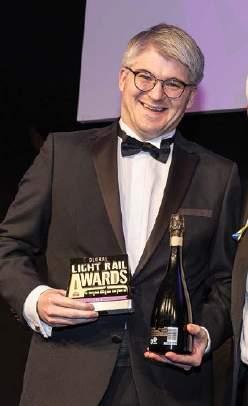
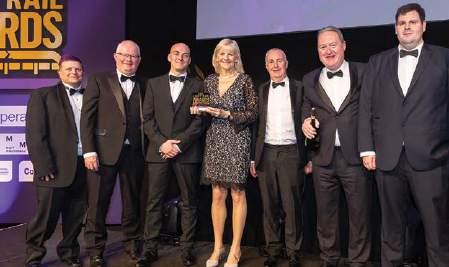


of 12 comes from a variety of professions for the annual illuminations, which attract hundreds of thousands of visitors to the North West UK resort’s seafront.
The 139-year-old system, last survivor of the UK’s first generation, maintains a number of historic cars that are lit up for nighttime outings. The drivers and conductors who make up Blackpool Transport Services Heritage Tramway Team have helped increase business 28% this year, while Facebook ‘ likes’ are up 130% compared to 2022.
A team from India were Highly Commended . Equality in the workplace is a sensitive subject, and Keolis Workforce for Women – WOW for short – was founded in Hyderabad, last year. It urges women to join male-dominated departments. In a fast-growing city of 12 million people and whose Metro carries 500 000 people a day, this operator has been internationally recognised and commended for its aggressive recruitment drives and mentoring programmes.
A big hitter on the world stage was invited to join the platform as Winner of Manufacturer of the Year – none other than Alstom
With over 8000 light rail vehicles to its credit over the last 30 years, in 140 cities, Alstom was praised for its consistently outstanding performance. The judges said of Alstom products: “They’re the VW Golf of trams; they’re reasonably priced, and they run well.”
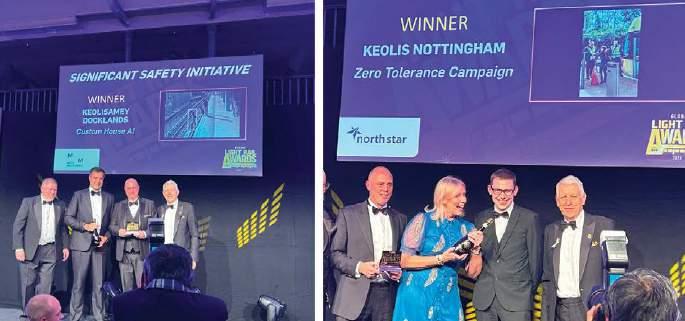
In the last 12 months alone, there has been activity in Rio de Janeiro, Barcelona, Strasbourg, Quebec, Toulouse, Pennsylvania, Paris, Cologne, Ecuador, Vienna, Delhi, Bangkok, Singapore, and Santo Domingo, to name just a few.
Highly Commended was Finnish newcomer Škoda Group, which is winning new business from customer feedback to its Jokeri X54 product. There was also a Special Mention for Stadler (a trophy winner in 2022) for the warm response to the first deliveries to the UK of the new Class 777 fleet for Merseyrail (Liverpool), and ‘555s’ to the Tyne and Wear Metro. The judges believe that greater recognition will come when the new trains have been proven in passenger service.
Metrotenerife was welcomed to the stage again as the Project of the Year <EUR50m Winner for a root-and-branch overhaul of its computer software. All around the world, technology progress is often held back by a requirement to integrate with older kit, and this Canary Islands’ system decided upon a complete clear-out, replacing five networks, often incompatible, with just one.
Live performance information is conveyed to the control centre, and teams can spring into action if there is a problem with a vehicle, track or signalling. With project HEIMDAL, an illuminated display is easy to understand, and as Nicholas Owen remarked; “It’s so simple… green means great, amber means warning, and red means get out and fix it now!”


The entries showcased many other inspiring and ground-breaking projects, and those shortlisted came from Austria, Turkey, the Middle East, and the UK.
Highly Commended was CAF Istanbul Metro. December 2022 brought the introduction of a new driverless fleet that allows services to run every 90 seconds. Extra trains can be put into service at the click of a mouse, and be parked anywhere overnight ready for instant use the following day instead of trekking back to the depot.
A nomination for the Rising Star award at the GLRA surely carries just as much weight as a professional qualification, and it is clear that those who enter their employees derive immense pleasure from broadcasting their achievements.
Five were listed for an award in 2023.
Hamish Falconer (Project Manager, Midland Metro Alliance and Colas Rail UK) is building Birmingham’s Eastside extension. Like all good leaders, he knows the value of teamwork, and always puts others first. Alliance Director Peter Cushing says: “He has a brilliant career to come.”
Katie Rigg works for Stadler in Newcastle (UK). Being made redundant from her retail store manager’s job after ten years in 2021 has turned out well. As a procurement assistant at the smart new Metro depot at Gosforth, she has
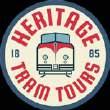

Wherever you travel in the world, you’re never far from an Alstom tram – and the grand total will soon run into five figures. François Giraud, Market & Product Director/Light Rail Vehicle Platform collected the GLRA’s Manufacturer of the Year accolade.
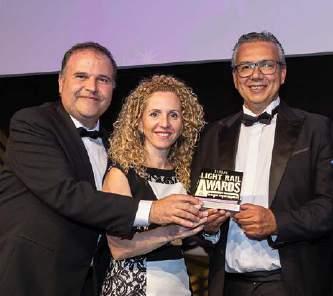
MetroTenerife’s problem-solving HEIMDAL exercise was named as Project of the Year under EUR50m. On stage are Damaso Arteaga, Teresa Benet and Jacobo Pérez.
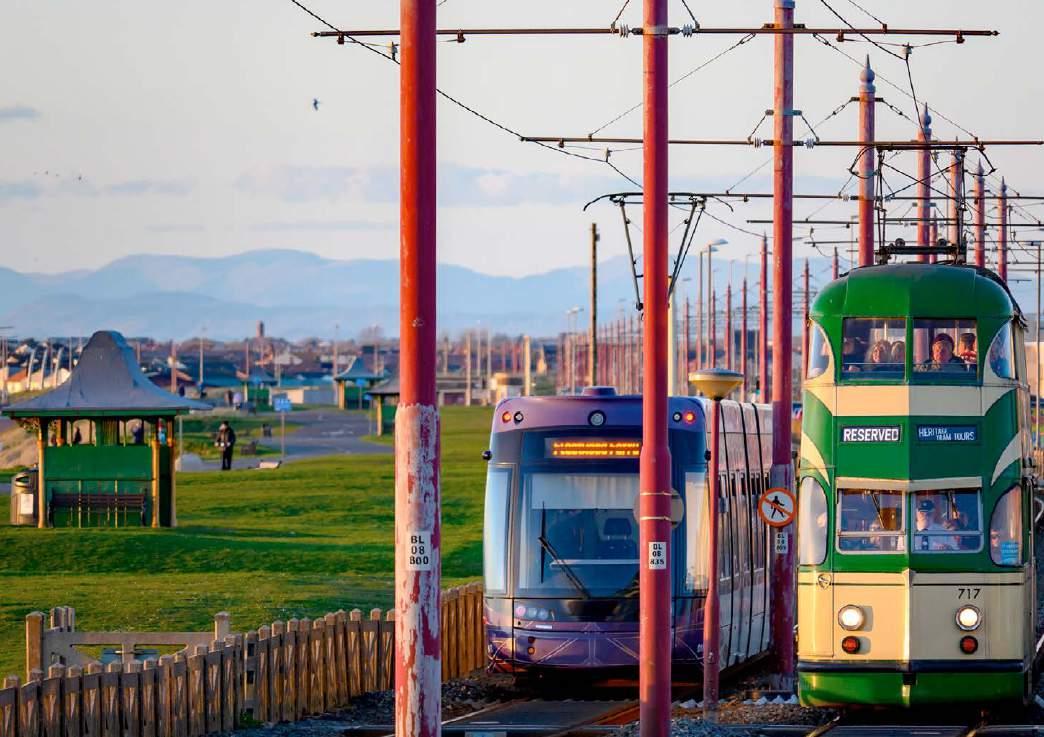

shown skill in buying in quality items at the right price.
Connor Hardy joined Nottingham Express Transit as a tram driver in 2019, and Keolis was quick to promote him to Safety Manager. There was a citation from HM Principal Inspector of Railways Dominic Long who said he is “… engaging, open, and honest to deal with, inspiring others to achieve the same high standards.”
Helen Cooper, Assistant Project Manager from West Midlands Metro, only joined the operation in April 2022 on a temporary contract, but has already been promoted twice. Her MD Sophie Allison says: “Helen adapts quickly and easily to changing situations to ensure that all her projects are successful.”
The GLRA judges were unanimous, though, in their choice of Winner Alexandra Sjöholm from the Škoda Group. She is credited for breathing new life into the Finnish tram manufacturer. Starting as a junior in the strategy department, she soon became head of marketing and sales, and achieved the seemingly impossible – an order from Germany.
Said her nominee: “I marvelled at her mastery of exceptional technical knowledge, genuine belief in the product and unwavering affection for her product. Her commitment is unwavering, infused with love, passion and fervour.”
Comfortdelgro, Singapore was chosen as Most Improved System Winner for

Tomorrow’s leaders: Three of this year’s Rising Star nominees were together on stage to collect their Highly Commended Awards – Hamish Falconer (Midland Metro Alliance and Colas Rail UK), Connor Hardy (Nottingham Express Transit) and Katie Rigg (Stadler UK). Helen Cooper (West Midlands Metro) was unable to be present.
its root-and-branch approach to improve a light rail system that had a poor reputation for reliability. Delays have been cut by a staggering 93%.
The Sengkang and Punggol lines have served the north of the country for 20 years, but have been bedevilled with inferior track and defective vehicles that have now been addressed by a concerted team effort. Meetings were sometimes held every day. One of the GLRA judges commented: “No-one passes the buck any more. It’s all about where we are now, not where we were.”
Highly Commended went to Metrotenerife for its on-board monitoring

Comfortdelgro in Singapore has upped service performance by an incredible 93% with its ruthless root-and-branch offensive on reliability. Phil Sanders collected the GLRA trophy for the Most Improved System on behalf of Comfortdelgro.
equipment that has sharply reduced the number of breakdowns; diagnosis of all equipment is continuously transmitted to the control centre.
The prestigious title of Global Light Rail Awards Operator of the Year 2023 has gone to the Middle East. The Winner, RKH Qitarat in Dubai, played a vital role in the 2022 Football World Cup. The state-of-the-art automated network, mostly underground and across the city of Doha, was pushed to the limit with six times its usual business, a total of 18.2 million journeys. Its tramway, now in its third year, has four lines and 25 stations.
Even without football, the Metro’s year-on-year growth has been over 70%, and the system can boast another amazing

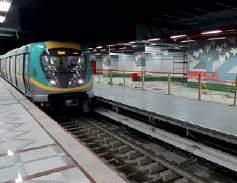
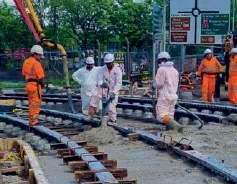


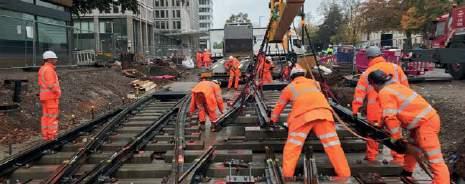

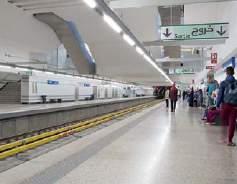

We have over 25 years’ experience in designing and delivering Light Rail systems in more than 50 cities around the world.

In the UK, we deliver design, construction and maintenance for light/metro rail projects.
Our range of skills and experience affords us the capability to offer our customers a flexible service, focused to meet their specific needs.
As principal contractor of the Midland Metro Alliance, we are proud to be delivering the largest light rail programme in the UK.

As well as footballers, another winner in the 2022 World Cup in Qatar was transport operator RKH, which handled 128 million passengers in a fortnight, and ran 100% to time. Representatives from RKH Qitarat collect the Operator of the Year award.
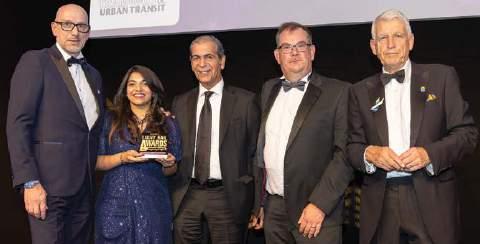
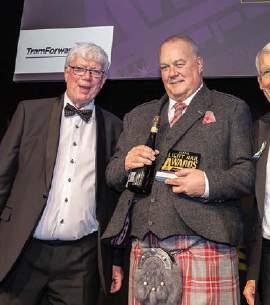
TramForward (award Chairmansponsor)
congratulations.
statistic: a full 100% of services – not 99.9% –running to time is often achieved.
Although narrowly missing out on trophies, a Special Mention was given to Keolis Downer Yarra Trams, Melbourne (Australia), Edinburgh
Trams (UK), Transdev Dublin (Ireland), and Transdev Sydney (Australia).
This year’s GLRA Vision of the Year award has gone to a city of almost six million people – Toronto – which generates 20% of Canada’s total economy. Its public transport needs a big vision, and Metrolinx has this with a CAD100m (EUR69m) programme to grow and integrate its extensive light rail and suburban rail routes. This means new strategic interchanges, electrification of heavily patronised lines, a new subway route, and 32km (20 miles) of new segregated light rail that is ready for the first services.
A Highly Commended award went to the Doha Metro in Dubai for its 2022 World Cup performance. SYSTRA Bologna was also given a Special Mention for tackling its poor reputation for traffic congestion, pollution, and road accidents in a classic city that is famed for having the world’s oldest
university. By 2030, a wireless tramway will run through this Italian city’s urban centre.
The GLRA judges made a Judges’ Special Award to an individual who has made an outstanding contribution through professionalism, dedication and passion, and at the same time led a complex new project to an immaculately successful opening: Colin Kerr, Head of Safety for Edinburgh Trams.
The judges offered this testimonial: “Over the last few years, and largely on Colin’s watch, the reputation of this expanding UK tramway has shifted from the naughty corner to becoming a centre of excellence, doing its job to absolute perfection.”
“When the new extension at Newhaven carried its very first tram on test at the beginning of 2023, who was walking in front to ensure that all went smoothly? Colin of course.”
Following his decision to step back from a full-time job, Colin had his arm twisted to work in Edinburgh a couple of days a week, and he is also valued by his colleagues as interim Chair of the Light Rail Safety and Standards Board.
The 2024 Global Light Rail Awards will be held on 2 October 2024.
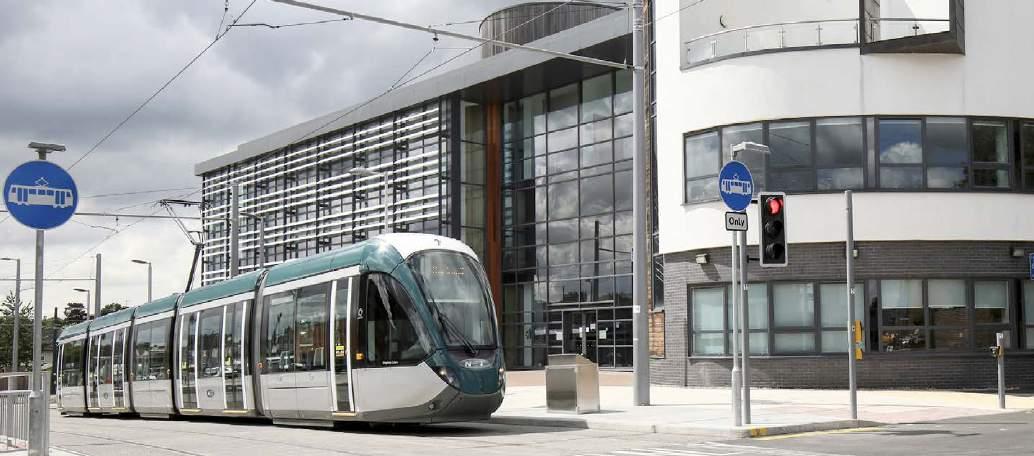

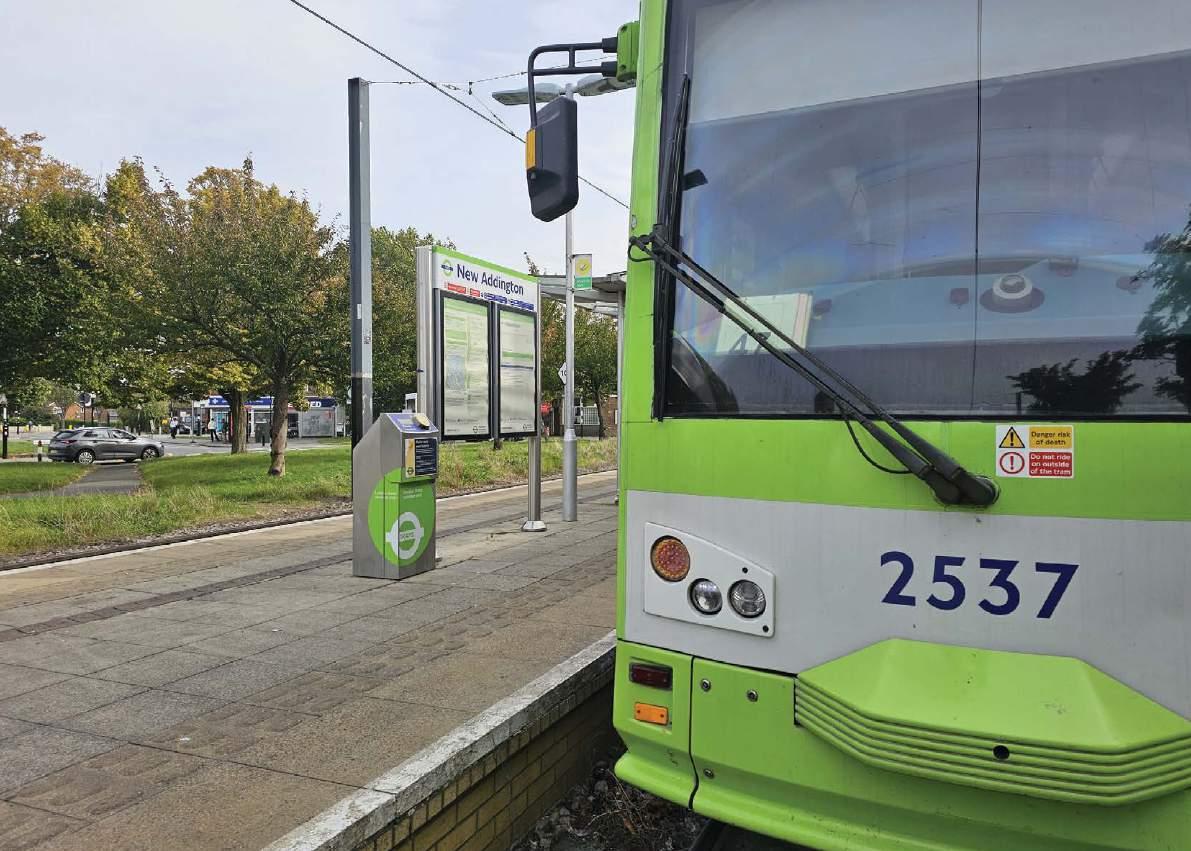
PROUD SUPPORTER OF THE COMMUNITY FAMILY PROJECT IN NEW ADDINGTON, CROYDON

can liverpool overturn the critics? jacinta Barnicoat offers some reasons why the uk is still sitting on the fence with light rail, and asks again: how much does a tramway really cost?
Liverpool City Region Mayor Steve Rotheram has set his team a massive challenge. He wants them to prove the case for reviving Merseytram, overcoming the resistance and prejudice that saw the UK’ s well-developed showpiece scheme suddenly abandoned back in 2007.
Rotheram says it might only happen if a new Labour government replaces the current Conservative administration; it will be a remarkable U-turn considering it was also Labour that cancelled the scheme. Rotheram, who takes great pride in his city – birthplace of The Beatles – would do well to heed some of the lessons that are outlined in TAUT ’s review of current prospects.
We have all moved on, but who can forget that Labour’s Secretary of State for Transport and senior economist Alistair Darling was anti-light rail because of the way that escalating costs were presented to him, not helped by infighting amongst local authorities.
As TAUT has explained many times during its 86-year history, constructing a tramway is never a cheap or a quick urban transit option.
It has been known for business case appraisals, securing funding and securing legislation to occupy planners and finance teams for practically their entire careers. Creating the infrastructure, on new or existing disused alignments, can be a minefield of delay and overspending if, for example, the ground is unstable or unrecorded utilities are discovered.
and popular for increasing property prices along the routes which it serves. So why are not more UK cities engaging with light rail? Put simply, the upfront costs are rarely perceived by politicians as vote winners. In the UK as well, the prospect of a number of local authorities becoming technically bankrupt in the next few years because they cannot fund existing social care programmes does not augur well for public transport schemes that might not seem essential in the short term.
Norman Baker (Minister for Transport in the coalition government from 2010-13), spoke on this very subject is his 2011 Green Light for Light Rail report. He said, “The high capital costs have meant that in practice, even where passenger forecasts may justify its consideration, light rail has often not been seen as an affordable option for local transport authorities to pursue.”
“Constructing a tramway is never a cheap or quick option. It has been known for business case appraisals, securing funding and securing legislation to occupy planners and finance teams for practically their entire careers. ”
It is no small wonder therefore that the cost can sometimes be an eye-watering figure – GBP180m (EUR200m)/km is not unknown. Happily this is not always the case, and the delivery of a tramway for under GBP1m (EUR1.1m)/km is also not unknown. How is this achieved, and why is there such a disparity between similar schemes? Given so many variations across systems, it is harmful to draw any bottom line comparisons.
The long-term benefits of light rail have been championed by world class consultancies, regional transport authorities, cities themselves and campaign organisations such as UKTram and TramForward. As nations worldwide now seem to embrace the move towards Net Zero emission targets, it would seem an obvious point that tramways and light rail should be at both the front and centre of it all.
Light rail is zero emission at point of use, thus ensuring cleaner air. Positioned midway between buses and metros, it is a highly visible people carrier in the urban landscape,
He made little progress in persuading either the electorate or the Department for Transport. Even when he left front line politics after losing his seat in Parliament, Baker was unable to slow down the purchase of fleets of buses, or indeed reinstate the Uckfield-Lewes heavy rail link on his own doorstep when the business case was considered sound.
Another issue that often dominates the headlines and muddies the light rail costing waters is the wide difference between prices published by schemes across the world. Opponents of light rail and other commentators will often point to the overall cost of a system and then compare the figure to another that was delivered for significantly less. This can be seen as showcasing light rail (especially in the UK) as a waste of local authority and public funds that could be channelled elsewhere.
Let’s compare the UK with Poland. Take, for example, the recent 2.9-mile (4.7km) Newhaven extension in Scotland’s capital city Edinburgh, which reportedly cost a total of GBP216m (EUR248m) and (per km) GBP47m (EUR54m, adjusted for inflation) as opposed to the 5km (three-mile) Gorka Narodowa extension in Krakow which has reported a total cost of GBP65m (EUR75m), or just GBP13m (EUR15m)/km. How is this possible? How can a longer tramway be almost GBP34m(EUR39m)/km cheaper to build?
Looking at the figures alone, it would be easy to accuse Edinburgh of being wasteful with its money. However, the figures mean little without the context behind them. For instance, the Krakow line was only in the planning stages when the COVID-19 pandemic hit, whereas for Edinburgh, the lockdown meant crucial delays outside of the original business plan. More unexpected costs for Edinburgh were generated through utilities being diverted and uncovering a medieval
graveyard during the preliminary groundworks. None of these challenges could have been foreseen when the original business case was submitted, but each has had a significant inpact on the cost.
Not that Krakow didn’t have its own location-specific challenges to overcome, including the need to build two 100m (110-yard) tunnels to serve the new extension that runs parallel to a main road, three new park-and-ride sites, and rebuilding the existing tram terminus. However, these have been only projected costs, so may well change when the system officially opens.
This comparison does not include a country’s different building and construction rules, the involvement of local government and its powers to direct and manage its own funding, period of construction, the cost of the tram fleet, training, employing new staff… the full list is a long one.
So, is it possible to ever compare tramway systems and the costs that they incur? Well the short answer is… no. Should we be able to? Definitely.
The UK in particular faces barriers developing light rail. Unlike mainland Europe, especially France, which has embraced the mode as a viable transport option, the UK seems to be dragging its feet. It is only now that Leeds is back on the agenda, and perhaps Liverpool.
Green Light for Light Rail, published by the National Audit Office, identified some of the barriers that prevent more cities and areas adopting light rail as a viable option. The first is (unsurprisingly) cost, a lack of standardisation across the industry as a whole, improving the capability of providers, reducing the cost of utility diversions (currently operators foot 92.5% of the bill whereas in France it is free) as well as the application of heavy rail standards.
Clearly, there is a need for more standardisation, so how can you effectively measure a system’s performance and effectiveness when the goalposts keep moving and there are no yardsticks to measure by?
There is of course another issue which causes impacts – public relations. It has been shown time and time again that once a new tramway is in place, people love their trams. According to UKTram’s
latest Tram Passenger Survey, customer satisfaction across all systems stands at 91%. That’s pretty impressive.
However, only 68% said that systems deliver value for money. Is this not a symptom of the perceptions surrounding light rail and its costs? Perhaps we, the industry, need to do more to show that the barriers are being reduced, some costs are out of our control, and some are a direct consequence of the way the odds have been stacked against light rail.
We are committed to developing transparent and robust standardisation, but will this hold fast under scrutiny? After all, it was reported back in 2006 that a just mile of motorway extension cost upwards of GBP30m (EUR34maround GBP50m/EUR57m when adjusted for inflation) and it would serve to encourage car use, further pollute the air and create more congestion.
However, road widening projects are rarely met with objection. As Norman Baker put it, ‘‘You cannot build your way out of traffic jams, you just move them or make them bigger.”
So what’s the answer? How does the light rail industry begin to break down these barriers and create a standardised framework for all new tramways and extensions to follow?
There is currently no definitive answer or framework – indeed as an industry we are still defining what the question is.
In future issues, we will begin to breakdown in more detail some of the issues and disparities on a country and system basis.
In the meantime, if you would like further information on published system costs, you can visit the Global Light Rail Data Portal – www.railintel.com, or read more in the systems factfile pages of Tramways and Urban Transit


once the UsA’s most car-friendly city, Los Angeles is gearing up for the 2028 olympics.
it now has the largest LrT system with more to come, reports Vic simons.
Los Angeles County is making a statement. It’s opened two highprofile light rail projects within the last 12 months – the Crenshaw Line and the Regional Connector – and its LRT mileage has now surpassed both Dallas (TX) and Portland (OR).
It has good reason for this. LA needs to shed its reputation for smog and pollution in the run-up to the 2028 Olympic Games. The city’s freeways are famously congested and will not cope with the millions of extra visitors that a global event of this magnitude will bring. Sustainable public transport is essential if the city is not to grind to a halt.
The greater Los Angeles area comprises five counties. Los Angeles County, home to the city itself, is bordered by Riverside and San Bernadino counties to the east; Ventura County to the northwest, and Orange County to the southwest. There are 18m people living in the whole five county area, while figures published in 2022 estimate that the city itself is home to just under 4m.
Pacific Electric operated fast and regular interurban services across the five counties until 1963, whilst the largely streetcar Yellow Car system provided extensive services within the city until its own demise that year. Since then, the car and the freeway have reigned supreme. Despite the pro-car
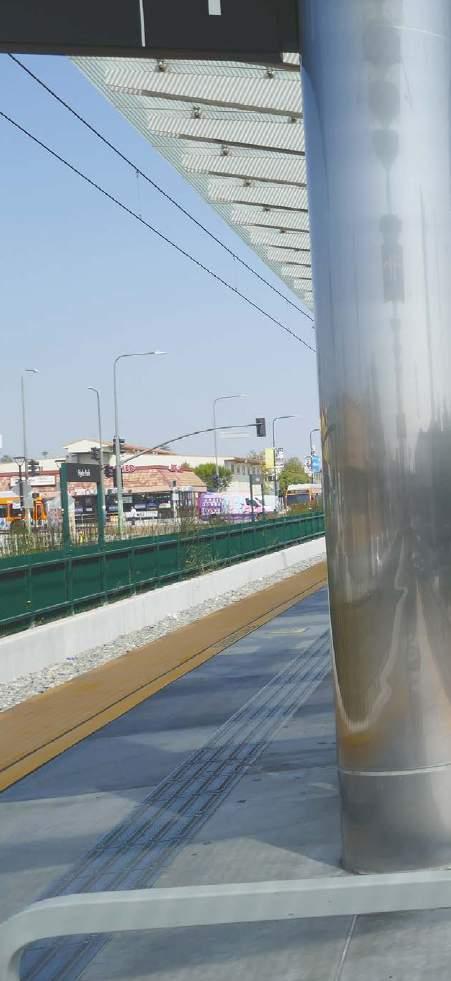
sentiment, remarkably, the city actually preserved much of the former right of way.
By 1980, it had become clear that simply building more freeways was not the answer to LA’s transport needs. This was exacerbated by the 1990 Northleach earthquake that badly damaged much of the freeway infrastructure but had minimal impact on the remaining rail system.
This provided the impetus to expand the light rail system.
Construction of the first light rail line, the Blue (L) Line, had started in 1985. It opened in 1990, using much of the former safeguarded Pacific Electric alignment to Long Beach.
The Los Angeles County Metropolitan Transportation Authority (METRO) is LA County’s main public transport operator. It controls 182km (114 miles) of light rail, two heavy rail metro-style operations, two dedicated busways, and it’s also responsible for much of the local highway system too.
The light rail, heavy rail and bus systems are to undergo big changes and expansion in the next few years.
The Regional Connector, which opened in June 2023, might only be 2.9km (1.8 miles) long but it has transformed the city’s public transport. It is an underground extension from the previous Expo/Blue Line terminus
at 7th/Flower under central LA and emerges close to Union Station. Its three new underground stations are Grand Avenue/ Arts, Bunker Hill and Little Tokyo (this replaces the former Gold Line surface station of the same name). It cost USD1.8bn (EUR1.68bn) and took ten years to build.
Two services now use the Connector: A Line and Line E.
At almost 80km (50 miles), the Long Branch – Azusa A Line is the longest light rail line in the USA. A USD1.6bn (EUR1.5bn) eastbound extension will add a further 14.6km (9.1 miles) to its length, and its four new stations at Glendora, San Dimas, La Verne, and Pomona will bring the total number of stops to 48.
Due to open in 2025, this extension shares the same corridor with a lightly-used freight line. Both systems will remain separate although building the new double-track light rail system has involved adjusting the main line alignment.
A further extension east to Montclair is planned to be open by 2030. When complete, it will be the first LA Metro light rail extension beyond the county boundary. However, METRO needs to secure USD798m (EUR755m) from the State of California to enable it to complete the first section. There are aspirations to extend the line even further east to reach Ontario International Airport.

The Expo (E) Line from the coast at Santa Monica to Atlantic in East Los Angeles also runs through the Connector. There is now no through-running from Azusa to Atlantic as the Connector has split the former Gold line in two. This is no real loss in operability as there were very few through journeys, as most travellers changed at Union station.
The Crenshaw (K) Line, which opened in October 2022, runs south from the Expo/ Crenshaw station on the E Line for 9.7km (6.1 miles) to Westchester/Veterans near Los Angeles International Airport (LAX). It cost around USD2.1bn (EUR 1.9bn) to build the part ground level/part underground/part elevated system. There are five intermediate stations: Martin Luther King Jr., Leimert Park, Hyde Park, Fairview Heights and Downtown Inglewood. There’s an E Line/K Line interchange at Expo/Crenshaw station.
The first two intermediate stations are underground before the alignment comes to the surface in the centre of Crenshaw Boulevard, just north of Hyde Park Station. Downtown Inglewood is a major traffic objective as the new line helps move crowds attending major events at the nearby SoFi Stadium, home to the LA Rams and LA Chargers NFL teams.
METRO expects the line to be extended south by the end of 2024 to LAX and a
connection with the C Line. Much of the infrastructure is in place, including a large viaduct that crosses the I10 freeway.
The objective is to maximise public transport usage options to and from LAX, and there are plans to extend the K Line further north to make a connection with the B line subway at North Hollywood (plus a
LA County’s bus services are worthy of consideration here too. The J Line Busway is a rapid bus service that uses dedicated lanes and the central reservation of I110 and I10 freeways as it passes through central LA via Union Station. The line starts at San Pedro and terminates at the El Monte transit centre in east LA.
The Pasadena North Hollywood link transit corridor is being evaluated as to whether the current Rapid 501 service can be improved to form a dedicated busway utilising a lane on the route 134 ten-lane freeway. Decisions on this are expected within the next two years or so.
It’s also worth noting that bus operator Foothill Transit has just bought two double-deck electric buses from UK manufacturer Alexander Dennis. Costing USD3m (EUR2.8m), these are the only fully electric double deckers in North America. Foothill Transit operates buses from downtown LA through Pasadena, serving the communities along the I10/I210 corridor.
connection to the Orange Line busway. This extension is currently at the design stage and the three possible routes are still being evaluated.
The 31.3km (19.6-mile), 13 station C Line (formerly the Green Line) is somewhat unusual. It uses the central reservation of I105 interstate for much of its length whilst using the trackbed of a former freight railway for the last section to its western terminus at Redondo Beach. Opening in 1995, C Line is entirely segregated and more akin to a light metro rather than a streetcar service. This enables fast running, with end-to-end travel times of around 34min.
The eastern terminus is at Norwalk and sits within the I105 and I605 road junction. There is an interchange with the L Line at Willowbrook/Rosa Parks station.
METRO is also evaluating a southern extension to Torrance Transit Center. Planning is at a very early stage but there is an aspiration to have it open by 2033.
Metro treats the G Line (formerly the Orange Line) as a rapid transit line rather than a bus route. The dedicated 28.5km (17.7-mile) electric busway (that can also be used by emergency vehicles) runs from North Hollywood subway east to Chatsworth Metrolink Station. Metro’s long term ambition is to have turned this into a full light rail operation by 2050.
rigHT: Two e Line car trains bound for east LA leaving the expo Crenshaw station, showing staggered platforms.
Vic SimonsPlanning for a wider future
Two further major light rail projects are expected to be completed within the next ten years. The closest to completion is the 14.7km (9.2-mile) East San Fernando light rail project that will take light rail from the G Line along Van Nuys to Sylmar where the alignment will turn northwest to Sylmar Metrolink station.

The 10.7km (6.7-mile) southern segment along Van Nuys Boulevard is set to open in 2030. It has cost some USD3.6bn (EUR3.4bn) to build due to the 11 new stations, ten electricity substations and new depot facilities that are required. Phase 2 of the project is still being scoped, however.
The West Santa Anna light rail project is also at the planning stage. The objective is to link southeast LA at Pioneer with Union Station. The northern part of the alignment is still being evaluated, with the key decision being whether to construct a separate direct alignment to Union station or, via the Regional Connector, share the A Line.
What is known is that there will be a new alignment running south east from Slauson on the A Line for 23.2km (14.5 miles) to Pioneer and an interchange station with the C Line. This would enable access to LAX and 2035 has been suggested as a potential opening date.
There is a short streetcar line under construction in Anaheim in Orange County, known as OC Streetcar. This 6.7km (4.2-mile) alignment is expected to be operational in 2024 and ten Siemens S70 streetcars have been ordered.
LA County isn’t just investing in new light rail systems above ground.
Its underground systems are also undergoing big changes. Subway Lines B and D are both full underground metro systems. Both start at Union station with B going to North Hollywood, while D currently terminates at Western/Wiltshire.
Line D is undergoing a USD10bn (EUR9.4bn) extension from its current western terminus to Westwood/VA Hospital. The 14.6km (9.1-mile) underground extension will open in three stages between 2024 and 2027. There is a longer-term aspiration to extend the line a further 4.8km (three miles) to the coast at Santa Monica with a terminus close to that of the current E Line.
Metrolink is a seven-line commuter rail service. Six of its lines terminate at Union station, while the seventh is a tangential line from San Bernadino to the east to Oceanside, a coastal region of Orange County, close to its southern border with San Diego County. Three services operate seven days a week, with four more only running at peak times. Additionally, there is the recently introduced local Arrow seven-day-a-week DMU service that links San Bernadino with Redlands.
The bulk of METRO’s light rail fleet comprises 235 P3010 articulated doubleended high floor railcars. These 27.1m vehicles were assembled at Kinki Sharyo’s
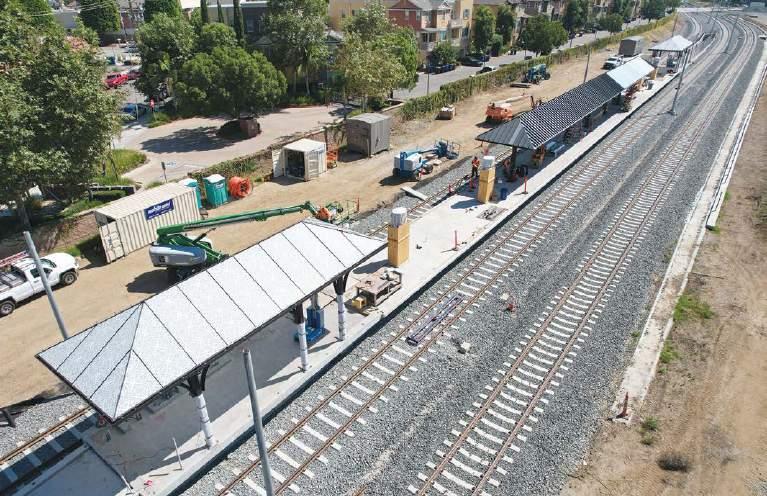
Palmdale plant to the north of LA. The last was delivered in 2021.
Ansaldo Breda built 50 articulated LRVs to similar dimensions between 2007-11. Both types seat 68 with capacity for more than 120 standees when crush loaded. There are also 52 articulated vehicles from Siemens, again to similar dimensions but with a crush load of 100. It is METRO’s policy that all vehicles can operate on all lines although the Siemens cars are usually found on the C Line.
LA County’s investment in public transport is impressive and its future plans are exciting, especially for somewhere so car-orientated.
However, there’s clearly a need to spread the message about the benefits of public transport: less than 20% of all trips being made use public transport.
The latest research shows that weekday ridership has only returned to 75% of preCOVID levels, reflecting anecdotal evidence that few non-peak services are busy. This decline can’t all be pinned on flexible working, for the freeways are still clogged most of the day. METRO is clearly doing its best, but may be fighting a losing battle.
Thanks to various officers from METRO and to Chris Burner and Albert Ho from the Foothill Construction Authority for their assistance in the production of this feature.
The cornerstone of the fare system in LA County is the TAP card, which is valid not only across METRO but also the other 25 public transport operators in the county. This is a reloadable plastic card about the same size as a typical bank card.
Travellers tap the reader at the start and finish of each trip as well as when interchanging. The chip in the card automatically deducts the fare value up to the maximum of USD5 (EUR4.75) per day or USD18 (EUR17) per week.
The base fare for a single trip as at October 2023 is USD1.75 (EUR1.65).
LefT: Taken in the summer of 2023, an aerial shot shows the construction of the foothill extension to Pomona. Courtesy of Foothill Gold Line Construction Authorityrob
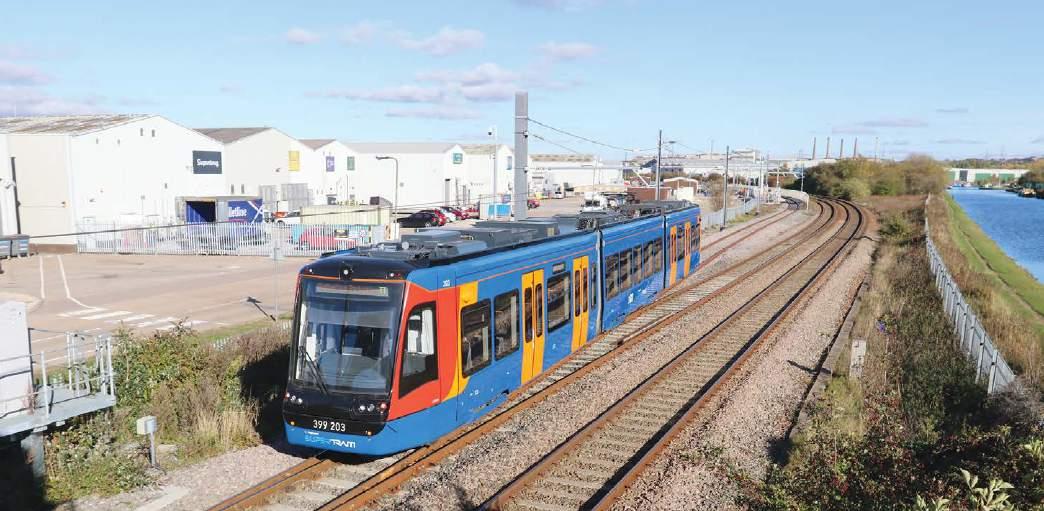
In 2007 Network Rail, Northern Rail and the Department for Transport (DfT) initiated a project to understand tram-train in the UK context.
Following a review of candidate locations and after development work over the next five years, in 2012 the thenParliamentary Under-Secretary of State for Transport, Norman Baker, announced full funding for the pilot project in 2012.
Over the next six years the project partners Network Rail, Stagecoach Supertram, South Yorkshire Passenger Transport Executive (SYPTE – now South Yorkshire Mayoral Combined Authority, SYMCA) Northern Rail and the project sponsor, the DfT, successfully overcame many challenges to deliver the first tram-train project in the UK into passenger service. Operation commenced on 25 October 2018 between Cathedral tram stop in Sheffield and a new Tram-train station at Parkgate Retail Park in Rotherham.
The service is operated by Stagecoach Supertram as an extension of the tram system with which it shares integrated ticketing. Experienced tram drivers, with the appropriate training for the heavy rail route, operate Stadler Citylink (Class 399) vehicles on both the South Yorkshire Supertram and Network Rail infrastructure, interworking with heavy rail passenger and freight trains. Stagecoach Supertram is an open access operator on Network Rail infrastructure with the required licences, safety certificates and track access agreement.
As well as delivering a new passenger service to better connect South Yorkshire, one of the key objectives of the project was to capture and disseminate the learning to make it easier to develop and implement tram-train projects in the future. This article contributes to that by providing an update following five years of passenger service.
With five years’ passenger service now complete, how has the service performed?
Keith Swallow, Head of Finance and Commercial at Supertram has monitored the service since its inception, and has all the performance data at his fingertips.
Prior to the COVID-19 pandemic passenger numbers were steadily rising, passing one million within the first 12 months. Like all public transport modes, patronage took a significant downturn from March 2020. However, over the past 18 months there has been strong recovery with the service on course to get close to two million passengers in the current year. The evidence suggests that growth has been strongest on the crossboundary flow between the tram and rail networks – highlighting the great benefit of tram-train’s ability to cross modes.
Evidence from independent passenger surveys shows that the public really like the tram-train service for its enhanced accessibility and ability to take them into the heart of Sheffield. In its first year it achieved unprecedented 100% satisfaction in a Passenger Focus survey.
Compared with other national rail operators the service performs extremely well in terms of punctuality and reliability. Since 2018 its punctuality rate (arrival within five minutes) has consistently been above 95%, while in the current year it has achieved 98%. Equally, the service is very reliable with over 99% of planned services running in the current year. Altogether this makes it one of the most reliable and punctual rail services in the country.

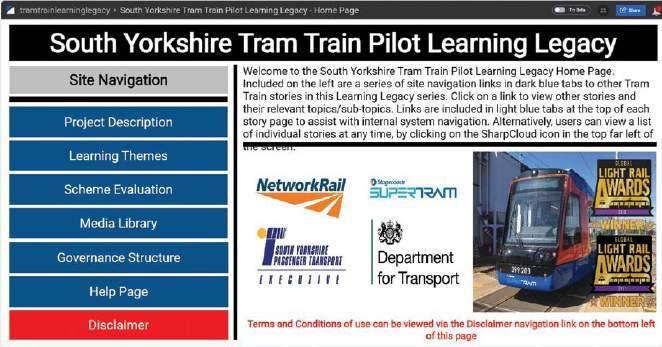
Access to the platform is free and available to all by request to: tramtrainlearning@networkrail.co.uk
o ver 70 organisations across the world are registered to use the learning hub, and it has helped promoters and consultants such as mott m acDonald on a range of projects. This includes Tram-train developments in s outh Wales and Greater m anchester as well as the further Tram-train
s outh yorkshire.
Operation has not been without its challenges. Widespread flooding has caused services to be suspended on several occasions, although mitigation works around Rotherham should help to prevent future recurrences. In the first severe frosts following service introduction, Network Rail’s dc overhead line electrification system froze up leading to service suspension – a lesson quickly learned and remedied by using ‘ice breaker’ tram-trains when sub-zero temperatures are forecast.
Of the seven Stadler vehicles purchased, up to three operate the tram-train service per day. The other vehicles provide additional capacity on the Supertram network. Overall, the fleet has operated nearly two million km (1.24 million miles) on the tram-train route. Teething problems, predominantly with software and some body defects, caused availability issues in the early years, but these are now generally resolved, and with the ability to swap Class 399s between tram only and tram-train mode, the reliability of the service has been preserved.
During the first five years of operation, tram-train has provided valuable experience to Network Rail, Supertram and SYMCA. Some of the key issues addressed include:
• Vehicle Identification System (VIS). To aid the correct routing of tram-trains on/off the main line route, Network
Rail adopted the Vehicle Identification System (VIS) used on the Supertram system. This was a new asset for Network Rail’s maintenance teams to be trained on. The system has needed fine-tuning with the original setup on Network Rail being too sensitive, leading to occasional failures. The experience gained helps to make future use of VIS and other similar tramway equipment on Network Rail infrastructure easier.
• Improving the system interface. The interface between the tramway and railway networks works well. However, the process does require the service to stop in what is referred to as ‘no man’s land’ on the track linking the Supertram and Network Rail systems while a manual system switch over is achieved; this adds about 90 seconds to the journey time. Network Rail and SYMCA would like to make the system transition more efficient and ideally remove the need to stop completely.
• Low level platforms on the main line. One feature of the tram-train system is the use of low height (395mm from top of rail) tram platforms on the main line at Rotherham Central. These were the subject of a detailed (safe by design) review prior to construction. They feature a fence between the tracks to deter trespass and automated audio/visual warnings of approaching trains. Platform gap fillers have also been installed as


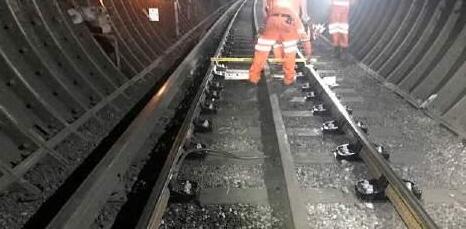
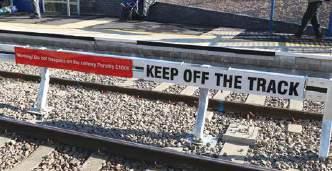
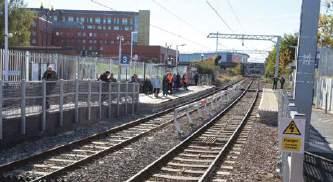
part of the tram-train operation. Since 2018 there have been no recorded safety incidents, and the experience is being put to good use in the design of the new tramtrain station at Magna.
• Mitigation against noise and vibration. Sheffield Supertram has utilised the Delkor RF196 Baseplate system on the Norfolk Park Viaduct since it was opened in 1994 (supplied by Tiflex Trackelast). The Delkor RF196’s remain in-service, performing well to this day, almost 30 years later. Additional Delkor baseplates have been supplied for installation.
To operate on the national rail network Stagecoach Supertram had to become a licenced Train Operator. As Keith Swallow explains, the experience is one that could be improved in the future: “One area the industry could look to improve is the apparent inflexibility in applying rules clearly intended for large train operators to smaller operators; in our case Supertram only runs over nearly 5.5km [3.3 miles] of railway. Examples include mandatory payments to British Transport Police, compulsory membership of the industry’s Claims Allocation and Handling Agreement, and dispute resolution procedures. None of these having been used since tram-train’s launch. The one-size-fits-all approach could be reviewed to simplify further light rail extensions.”
The South Yorkshire Supertram system is owned by SYMCA and has been operated and maintained by Stagecoach Supertram for the past 26 years. The concession with Stagecoach ends in March 2024, with the operation and maintenance of the network transferring to a new company owned by SYMCA. Bringing the operation back in house helps to facilitate a major renewals programme that is underway, funded through the DfT’s City Region Sustainable Transport Scheme (CRSTS). Along with the operation and maintenance of the tramway, the new company will take over the operation of the tram-train service requiring it to have the licences, safety certificates, and
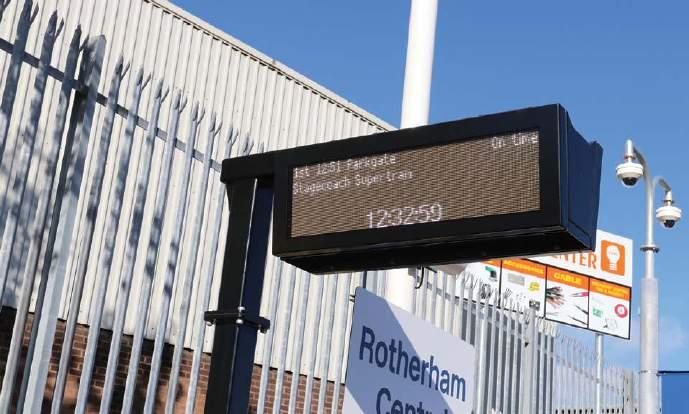
track access agreement required for operating on Network Rail.
One of the issues over the past five years has been a lack of integration between the signalling systems used on the heavy and light rail networks. Not only does this mean Network Rail signallers and Supertram Network Coordinators cannot see the location of tram-trains on each other’s networks, it also means accurate real time information cannot be provided for tram-trains until they arrive on Network Rail infrastructure. Whilst this doesn’t pose too much of an issue when services are running to timetable, in times of disruption this cannot easily be communicated to passengers.
As part of the renewals project SYMCA is in the process of going to market for a new operational control system that will integrate with Network Rail signalling. This will allow integrated passenger information to be provided at all tramway stops and tram-train stations, alongside web-based information.
On opening, the park-and-ride site at Parkgate had only 30 spaces, which was quickly increased to 95 spaces once it was realised how popular the tram-train service was. Parkgate park-and-ride is handily located for providing easy access from the wider Rotherham and Dearne Valley areas into Rotherham, the lower Don Valley, Meadowhall, and the centre of Sheffield. To develop this traffic and reduce the number of cars travelling along this route, SYMCA has plans to expand the park-and-ride site to 300 cars over the next few years.
The tram-train route has a 4km (2.5-mile) section between Tinsley/Meadowhall South and Rotherham Central with no stops. SYMCA, with Network Rail, is currently in the process of delivering an additional stop at Magna near the middle of this section. Along with serving the Magna Science and Adventure Centre it will also provide an additional park-and-ride for 100-150 cars with easy access from the M1 motorway. It is expected that this will be open for passengers in 2024, and is being delivered taking into account the lessons learned from the operation of Rotherham Central and Parkgate. SYMCA is currently revising its transport strategy that will shape transport projects and policy over the next 20 years or so.
a passenger information display at rotherham Central, which only shows live information once a tram-train is on network rail infrastructure.
rob carrollIt is expected that tram-train will feature heavily in this document, with a vision of expanding tram-train services across South Yorkshire to provide a regional network with turn-up-and-go services. Options include looking at running on existing lines, reopened lines (through the Restoring Your Railways programme) and brand new lines. With growing patronage, a highly reliable service and high levels of customer satisfaction, the first five years of operation have shown that, once introduced, tramtrain delivers for passengers. With additional stops being delivered and extensions being planned, the future for Tram-train in South Yorkshire looks bright.
The authors are grateful to Keith Swallow, Head of Finance and Commercial at Stagecoach Supertram and Patrick Gannon, Tram Concession Manager at SYMCA for their help in writing this article.
rob c arroll is part of mott m acDonald’s Light r apid Transit Practice and was previously involved in the u K tram-train pilot on behalf of stagecoach supertram. he is responsible for tram-train activities across the u K including delivery roles for clients on the u K’s biggest tram-train scheme in s outh Wales and future routes in Greater m anchester. mott m acDonald is a multiple award winner at the Global Light r ail Awards, including as 2023 supplier of the year, and can draw upon its knowledge of all u K L rT systems, a global portfolio of heavy and light rail projects, and its successful design role as part of the team that delivered the u K tram-train pilot and developed the vision for s outh Wales metro. Simon coulthard is head of Light r ail at Network r ail. he took up the position in 2019 after leading the delivery of the u K tramtrain pilot. simon’s team provides a centre of excellence in light rail knowledge supporting development of new tram-train and light rail schemes on the national rail network, including the restoring your r ailways programme. simon oversees the management of the tram-train Learning hub; a free to use industry resource. The hub was Project of the year at the Global Light r ail Awards 2021. simon is vice c hair of ui TP’s regional and suburban r ailways committee.
The southern German city of Freiburg im Breisgau has continued to expand. Andrew Thompson reports from the fringes of the Black Forest.
Located on the western edge of the Black Forest and near the borders with both France and Switzerland, Freiburg im Breisgau features Germany’s southernmost tram system. The metre-gauge network, which first opened in 1901, currently has a length of 36km (22 miles) and was most recently expanded during summer 2023.
In mid-June the roughly 600m long realignment through Waldkircher Strasse opened, replacing the previous and less direct route through Kontur Strasse north of the city centre. The revised routing is served as before by line 2 but features a greater percentage of reserved track and better connects a fast-growing residential district with new housing developments and up to 4000 inhabitants. An additional two stops at Zollhallenplatz and Eugen-Martin-Strasse provide ideal access to the tramway, while the turning loop at Hornusstrasse has remained unchanged.
Freiburg currently has a population of roughly 236 000, with about 661 000 in the wider region. Situated in the state of
BELOW: On 21 June 2023, bi-directional Duewag GT8Z 257 calls at the new Zollhallenplatz stop on the realigned route through Waldkircher Strasse. This infrastructure project cost about 19.4 EUR. All images by Andrew Thompson
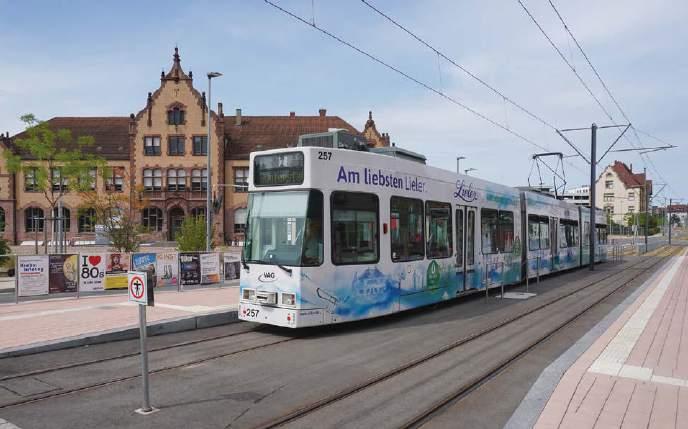
“Although modest, the tramway’s recent infrastructure expansion marks the fifth extension of the system in the past ten years... adding more than 6km (3.7 miles) of track to the network.”
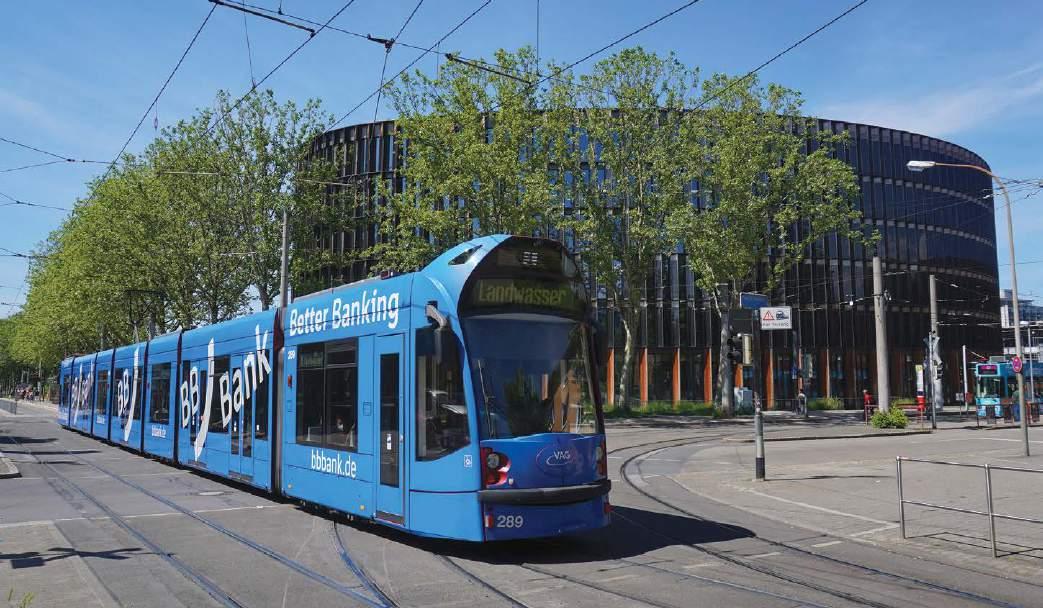

STADTWALD
Landwasser Moosweiher
Diakoniekrankenhaus
Moosgrund
Paduaallee
MUNDENHOF
Rieselfeld Bollerstaudenstraße
Maria-von-Rudloff-Platz
Geschwister-Scholl-Platz
Betzenhauser Torplatz
BETZENHAUSEN
Am Bischhofskreuz
Bissierstr.
Rohrgraben
Am Lindenwäldle VAG-Zentrum Haid Munzinger Str.
Messe
Stadion
Technische Fakultät
Elsässer Str.
Berliner Allee
Zähringen Gundelfinger Str.
Eugen-Martin-Str.
Zollhallen-platz
Hauptfriedhof
Fr.-EbertPlatz Killianstr.
Rathaus im Stühlinger
Runzmattenweg
Bugginger Str.
Krozinger Str.
Scherrerplatz
Eschholzstr.
Robert-Koch-Str.
Fahnenbergplatz
Hauptbahnhof Stadttheater
Haslach Bad
Dorfbrunnen
Glottertalstr.
Berggasse Reutebachgasse Tullastr.
Hornusstr.
Okenstr.
Hauptstr.
Tennenbacher Str.
NEUBURG
Europaplatz Bertoldsbrunnen Oberlinden
Schwabentorschleife
Erbprinzenstr.
Holzmarkt Mattenstr.
Reiterstr.
Pressehaus
VaubanMitte Vauban Innsbrucker Straße
RIGhT: The most scenic of Freiburg’s tram routes is the southern tip of line 2 to Günterstal, as it briefly runs overland through fields and forests and has the feel of a traditional interurban route. At Günterstal it terminates in the foothills of the Black Forest, in a quaint village setting. In this picture from September 2020, all-white Duewag GT8Z 253 passes through the single track archway just before Klosterplatz, the penultimate stop on the line.
RIGhT: At Technische Fakultät old and new stock rub shoulders, as the teak-bodied car 56 stands side-by-side with the sleek Urbos 309 in blue advertising livery. The extension from RobertKoch-Strasse to Technische Fakultät opened in December 2015. In December 2020 it was extended to Messe, thereby not only serving the exhibition centre, but also Freiburg’s new football stadium which opened in 2021. Freiburg’s current network consists of the regular tram lines 1 to 5.
Even with all the recent extensions that have been implemented in Freiburg, the network will continue to grow before the end of this decade. There is already political consensus and concrete planning underway for a short eastern extension of line 1 by three stops to Kappeler Knoten, where a large park-andride facility for up to 500 cars is also slated to be built. Construction could start in 2025/26 with works expected to require two years. At the western end of the light rail system, line 5 is expected to be extended by three stops from Rieselfeld to the developing district at Dietenbach. This scheme is currently planned for implementation from 2025-27.
Musikhochschule
Schwabentorbrücke Brauerei Ganter
Heinrich-vonStephan-Str. Johanneskirche Lorettostr.
Weddigenstr.
Peter-Thumb-Str.
Holbeinstr. Wonnhalde
Paula-Modersohn-Platz
Maria-Hilf Kirche Alter Messplatz
Wiesenweg Klosterplatz Günterstal Dorfstr.
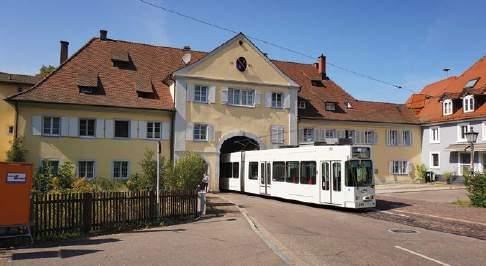
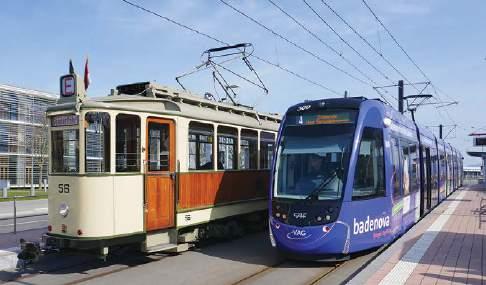
Hasemannstr.
Römerhof
Emil-Gött-Str.
Littenweiler
Lassbergstr.
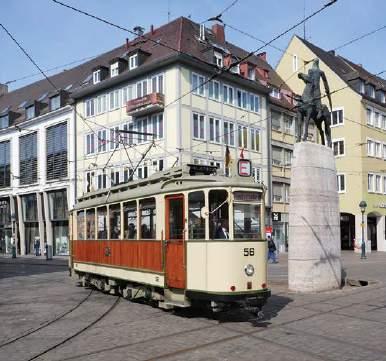
ABOVE: Freiburg boasts an impressive heritage collection that includes no fewer than ten preserved trams, although not all are currently operational. While car 45 from 1914 is the oldest in running order, the stalwart is the four-axle car 56 from 1927. This was part of a series of nine such bogie vehicles built by the nearby Waggonfabrik Rastatt. The class was in regular service until 1978. Today, car 56 is frequently seen on the local heritage line 7, which runs on selected weekends, generally once a month between May and September. Line 7 and all the local vintage vehicles are operated by the friends group Freunde der Freiburger Straßenbahn e.V., which mainly consists of current or retired employees of the municipal transport operator VAG. Line 7 runs along the route Paduaallee – hauptbahnhof –Bertoldsbrunnen – Musikhochschule. On 24 March 2018, car 56 is on a private charter via Bertoldsbrunnen in the heart of the old town. numerous tram lines intersect at this central point.
Baden-Württemberg, the city benefits from its proximity to major population centres in neighbouring France and Switzerland, such as Strasbourg, Colmar, Mulhouse and Basel. Despite appearances, Freiburg’s city centre largely dates from post-World War Two, following destruction by air raids.
Although modest, the tramway’s recent infrastructure expansion marks the fifth extension of the system in the past ten years; these have together added more than 6km (3.7 miles) of track to the network and correspond with the university city’s general, vibrant development. Major achievements, largely under the banner of the Stadtbahn 2020 programme, include the creation of light rail links to the campus of the university’s technical faculty as well as the football stadium and the exhibition centre. Looking back further, three other network enlargements were implemented in 2002, 2004 and 2006, after the system had been boosted by six extensions opened between 1983-97. In 1983 itself the Stadtbahnbrücke bridge was opened, taking the tramway as well as footpaths directly over the platforms at the city’s main station (Hauptbahnhof), and allowing easy interchange between light and heavy rail modes.
By 2015 it was being reported that 70% of urban journeys in the city were being made without a car, the highest such figure anywhere in Germany.
Electrified from its inception in 1901, the tramway has been worked since the start by municipal operator Freiburger VerkehrsAG (or VAG). As with other modes of local transport, the network also comes under the Regio-Verkerhsverbund Freiburg tariff union.
There are currently five lines, with Bertoldsbrunnen a key central point:
1 (Litenweiler – Bertoldsbrunnen – Landwasser), 2 Günterstrasse –Bertoldsbrunnen – Hauptbahnhof –Hornusstrasse, 3 Vauban – Bertoldsbrunnen – Haid, 4 Zähringen – Bertoldsbrunnen – Messe, and 5 Rieselfeld – Haslach –Stadttheater – Europaplatz.
Although there were previously depots in both the north and south, there is now just a single regular depot and operational centre, located adjacent to the stop at VAGZentrum in the west and dating from the 1970s. In addition, part of the old southern depot in Wiehre is utilised by the Freunde der Freiburger Straßenbahn for its classic fleet.
On the rolling stock front, Freiburg’s newest low-floor trams are the 17 CAF Urbos, which were delivered in three separate batches from 2015-21. An option for an additional eight has been exercised and the first of these 43m, seven-section LRVs arrived in midSeptember; it should enter revenue service in December 2023. Completion of delivery for the entire series is expected by late 2024.
The Spanish XL trams are complemented by eight Siemens Combino Basic from 19992000 and ten Combino Advanced from 2004-06. Freiburg’s first-generation low-floor trams are the 26 Duewag GT8Z These double-ended vehicles feature an angular front-end, the city’s classic dark red
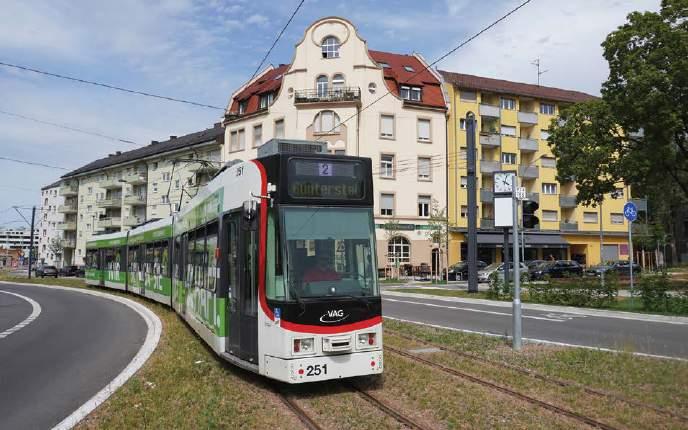
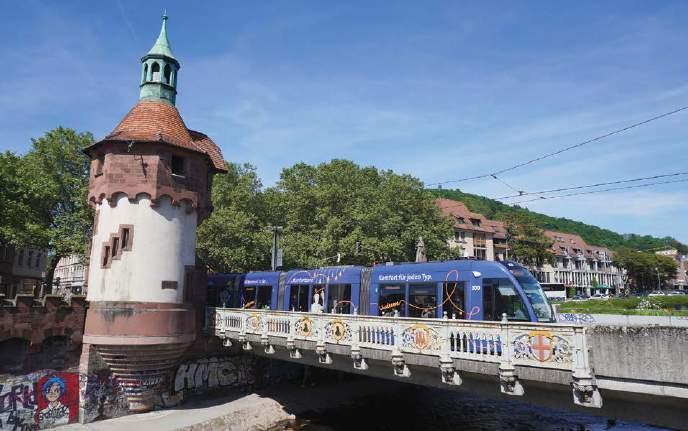
Littenweiler use the single track alignment over Schwabentorbrücke,their inbound equivalents use the single track section over Greiffeneggbrücke. CAF Urbos 309
and white livery and a low-floor ratio of about 48%. The LRVs were first delivered in 1994 and received a comprehensive mid-life refit between 2012 and 2021. While the GT8Z series will therefore still serve Freiburg for many years to come, one vehicle was lost to an accident in February 2023 and has been deemed beyond reasonable repair, thus reducing the GT8Z roster to 25 trams.
Freiburg has always been known as a Duewag hotspot and no fewer than three separate series of GT8 articulated cars have operated in the city. The first batch of four was delivered in 1972 and used in service until 2001. Thanks to favourable experiences with the first four vehicles, a further ten were ordered a decade later and delivered in 1981-82. These were 12cm wider than the earlier variants, thus allowing a slightly more spacious interior specification. From this second batch, vehicles 212 and 214 were still in revenue service as of summer 2023 and used on weekdays on lines 1, 3 and 4.
The newest batch of 11 Duewag GT8N dates from 1990/91. As a modern feature, they included a low-floor centre module as part of their modified design, making them partially barrier-free. In 2001, these
while running outbound to Littenweiler.
LRVs were also retrofitted with dot matrix destination displays. It is expected that this series will gradually be replaced after 2024 by the latest supply of eight CAF Urbos, though given the partial accessibility and operational versatility of the GT8N, there is no immediate pressure to rush the decommissioning process and some are likely to function as reserve vehicles. As of now the GT8N are also deployed on the weekday lines 1, 3 and 4.
Clean and green urban transport is not just a feature of Freiburg’s urban tramway, as over the past five years various lines of the regional S-Bahn railway network have been electrified. These include the Freiburg – Breisach and Breisach – Riegel – Gottenheim routes, as well as the branches from Bad Krozingen to Münstertal and from Denzlingen to Elzach. These main line improvements make it possible for commuters to enjoy faster and more efficient railway services from the regional periphery as well as the more nearby suburbs to Freiburg Hauptbahnhof.
For more on Freiburg’s tramway, see TAUT 932, August 2015.
ABOVE: Duewag GT8Z 251 is at Kaiserstuhlplatz, where the new alignment onto Waldkircher Strasse diverges from the route through Komturstrasse. The new tracks are framed by greenery and run on reserved formation.
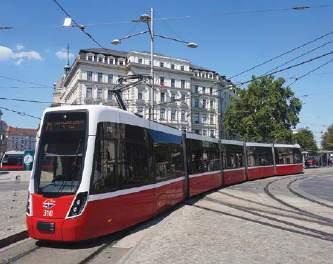
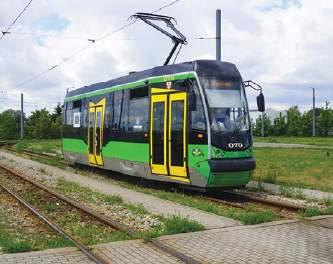






andy Willetts, amey
’s
Principal consultant for rail, explains how to use data and digital solutions to drive efficiencies across the mobility sector.
Public transport has changed a great deal within the past ten years, with urban mobility undergoing a huge transformation. Digitalisation and innovation have been behind many of the exciting changes to the ways in which we live and move.
The digital evolution moves quickly, and with each new development within IT, every step – every journey – puts us closer to the people-centric approach that the sector must remain focused on.
Before the pandemic, the UK’s rail and tram services were largely organised around commuter travel, which accounted for nearly half (47%) of all journeys. Now, the shift to dynamic, remote and hybrid working means commuter journeys are highly unlikely to return to their previous volumes.
However, that doesn’t need to mean a decline in demand for rail and light rail; far from it. As one of the least carbon-intensive modes of travel, the tram has a pivotal role
to play in the UK’s transition to a net-zero economy. And with the tram networks delivering passengers directly into town and city centres, they offer many advantages over car- and air-based travel.
Digitalisation is a major and evolving trend in global business and everyday life. It refers to the adoption or increase in use of digital and computer technology by an organisation, an industry, or a country. In other words, it represents the use of digital technologies to: Improve processing efficiency
Lower overall costs
Enhance productivity (for example operation and maintenance)
Provide new revenue and value-adding opportunities.
The rail and light rail sectors are witnessing a rapid adoption of technologies. In the last two decades, transit companies around the world have implemented new technologies to make passengers’ journeys more comfortable. Other than transporting passengers between originating points and
both rail and light rail sectors are witnessing a rapid adoption of technologies, with real-time information at stations and smart stops becoming the norm. digital information boards are prominently displayed at Xinshi 1st road on the danai system in taipei. Neil Pulling
destinations, these public transport systems continue to embrace evolving digitalisation for the provision of services such as security, customer service assistance, and operational support.
Stations in existing railway networks often face serious capacity problems at peak times, causing safety issues and reducing the customer experience. As passenger footfall increases there is high demand for real-time information to be fed directly to customers, notifying them of service interruptions. More and more stations will need to find solutions to these problems in order to ensure public transport remains an attractive mode of transport.
Mobility data is becoming more personalised, identifiable, and predictable. This has enabled a layer of new technologies, supported by automated and artificialintelligence-powered solutions. Amey has devised solutions via its ‘People Movement


abOVE: Prior to the cOVid pandemic, commuter travel accounted for almost half of all rail/ tram journeys. the shift to dynamic and hybrid working means these patterns have now levelled out throughout the day and week, meaning that commuter journeys are unlikely to return to their previous volumes.
Anna Dziubinska /Unsplash
lEft: although travel patterns have changed since the pandemic, footfall is increasing, leading to a higher-than-ever demand for real-time information to be fed to customers, notifying them of events such as changes to services – such as is displayed here at st Pancras station, london, UK.
Neil Pulling
bElOW: Passengers are set to benefit as mobility data becomes more personalised and predictable, with streamlined journey planning apps and timetables, improving accuracy and making it easier for people to plan their journeys.
Daria Nepriakhina / Unsplash
Portal’ that provide insights into where and when people move, journey analysis, dwell time and what mode of transport they use.
Big data can also reveal opportunities for new business models, such as retail provision in passenger areas informed by data on passenger circulation. Yet by using data there are significant benefits for passengers:
• Passengers set to benefit from more streamlined journey planning apps and timetables through measures to improve transport data
• Better use of data can improve interconnectivity between different types of transport, support the development of journey-planning apps and improve their accuracy, ultimately helping make it easier for people to use and plan journeys.
Operators are now looking at ways of customising dashboards which feed from real-time data. The ability to obtain status information and offer quick responses to queries is vital to keeping trains and trams on time and in turn ensuring passengers are happy with the service.
Data collected from bespoke hardware and software applications can be analysed for trends, component life-cycles, or human failure, which means issues can quickly be pinpointed and rectified. This results in services reliably running to the timetable. In addition, more services can run at once due to effective planning, and there is a lower chance of breakdowns mid-journey across the network.
Maintenance of transport networks is traditionally carried out using manual paper-based methods. These have been used for many years, but are time-consuming and costly due to the ‘reactive’ approach that many organisations apply to maintenance regimes.
Use of big data in operations and maintenance addresses a common Achilles’ heel in asset management: prognosis. The accurate estimation of the remaining useful life of an asset is key to the success of any transport organisation.
The industry is witnessing a shift in asset management regimes, and efforts are in place to switch from periodic maintenance to condition-based and predictive maintenance.
Predictive maintenance techniques are designed to help determine the condition of in-service equipment to predict when maintenance should be performed. This approach promises cost savings over routine or time-based preventative maintenance, because tasks are performed only when warranted.
The main agenda of predictive maintenance is to allow for the convenient scheduling of corrective maintenance and prevent unexpected equipment failures. By knowing which equipment needs maintenance, work can be better planned.
As well as reducing cost, the predictive maintenance enabled by big data improves safety across the maintenance workforce. The current reactive and periodic maintenance process means that workers are on the network, and therefore in a high-risk situation, on a regular basis.

With predictive maintenance, assets are only repaired or replaced when necessary, meaning workers don’t need to be on the track as often. It is estimated that conditionbased maintenance can reduce manual diagnostics by at least 60%.
Furthermore, predictive maintenance plays a vital role in helping reduce the carbon footprint when carrying out maintenance activities. By using data driven maintenance, rail operators can effectively manage assets more efficiently by using technology to deliver real time insights and outcomes into asset condition and reduce the need to carry out site visits. This provides a better way of working as it reduces labour costs/wastage/expense. As an engineering company that delivers vital services across the built environment and transport infrastructure, Amey recognises the importance of reducing its impact and supporting clients to achieve their carbon and climate change ambitions.
Artificial intelligence may be the answer to smarter maintenance and improved passenger services. The UK rail and light rail industry carries a billion passengers every year. For us to better appreciate what can be done to improve their experiences, we first need to see what lies at the root of their dissatisfaction.
On top of this list is how much passengers are paying for their commute. Transport Focus’ 2021 report, Return to Rail: What do Passengers Want? found that eight in ten passengers want a system overhaul, nine in ten want smart or electronic tickets, and eight in ten want the fare system to be reformed.
It is well-known that the existing ticketing system is complex and causes passenger dissatisfaction. Examples include anomalies like split ticketing (whereby it is cheaper to buy multiple tickets for a journey than single journey tickets for the same trip) and paying a peak-time fare when half of a passenger’s trip is on an off-peak service.
Despite the pain points and hurdles, there is clearly a desire from train operators, station managers and government to innovate and use technology to improve the customer experience.
Artificial intelligence (AI) may be the solution as it is having a profound effect on both our personal and professional lives, including across the transportation sector. Powerful new AI-enabled applications could help boost and revive the global rail industry.
However, for railways to reap the full benefits of digitalisation, they must expand the use of AI across both rail operations and rail infrastructure.
AI is helping make all transport modes safer, cleaner, smarter, and more reliable. It can help reduce traffic congestion, identify risks, manage transport, analyse travel demands, and even reduce greenhouse gas emissions.
Today, we’re seeing AI being used in rail applications to improve train scheduling, manage train speeds, avoid accidents, predict delays, enhance asset management, and more. These AI applications help ensure public safety, deliver customer value, and optimise overall rail management and operations.
Rail engineering companies such as Amey are helping identify future transport mobility needs by creating digital solutions to help drive down cost, and improve efficiencies and operations. They do this using data that provides valuable insights and improved decision-making. In turn this will improve infrastructure and rolling stock maintenance, improve services and drive footfall back onto the rail networks and improve the customer experience.
Digital development provides a unique opportunity for rail operations to become an integral part of the transition towards a greener and more sustainable public transport mode.
Belgium’s coastal tramway combines the roles of interurban link, local transport and support for the tourist industry.
By Neil Pulling.
Kusttram (Coast Tram) is true to the name in that it shadows most of Belgium’s North Sea shore. ‘Shadows’ is used advisedly, for little of the 67km (42-mile) route of the uni-directional system lies alongside the sea.
Rare amongst light rail operations, it attracts coverage in the general media, usually being identified as the world’s longest tram line. Kusttram is wholly within West Flanders province, part of the Dutch-speaking Vlaanderen (Flanders) region. It is one of three tram operations, all metregauge, in the network run by the regional government’s transport body, Vlaamse Vervoermaatschappij De Lijn, with services branded as De Lijn.
De Lijn was created in 1991, with part of its extensive bus operation extending into the Belgian capital, Brussels. Its Gent and Antwerpen tramways radiate from their respective
centres, whereas Kusttram is a linear interurban service.
The origins also differ, for the city systems have been municipal operations for most of their existence. In contrast, much of today’s Kusttram route came into the care of the national body charged with running local railways, Nationale Maatschappij Van Buurtspoorwegen (NMVB). This existed from 1884 until the dispersal of public transport responsibilities (except for heavy rail) to Belgium’s three regional administrations in 1991. The French name for NMVB, Société Nationale des Chemins de fer Vicinaux (SNCV), yielded the Vicinal name by which such operations were known, amongst which Kusttram became the most substantial survivor. Shorter sections were incorporated on Charleroi Metro in the Francophone Wallonie region and some NMVB alignment in Brussels was re-gauged for use by STIB/MIVB trams.
ABOVE: Zeelijner 6144 heads into Nieuwpoort on 24 July 2023 past the King Albert I Memorial and West Front Museum, built at a location directly related to World War One history.
Neil PullingWithout now quite reaching the national frontiers, Kusttram nevertheless connects a string of municipalities between the resorts of De Panne, which adjoins France, and Knokke-Heist, which borders The Netherlands. Between these two, Blankenberge and De Haan also fostered early examples of tourism, initially for a wealthy elite. Higher volume trade grew and became geographically dispersed as railway and tram coverage expanded.
The 20th Century’s second half saw more in-filling between the towns. Indicating demand for longer stays, large residential blocks were built, adding brutalist styling to the low-rise restraint of buildings and open spaces which had previously characterised the coast.
A near-straight 112km (70 miles) between Brussels and Oostende encompasses the cities of Gent and Brugge, internationally still better
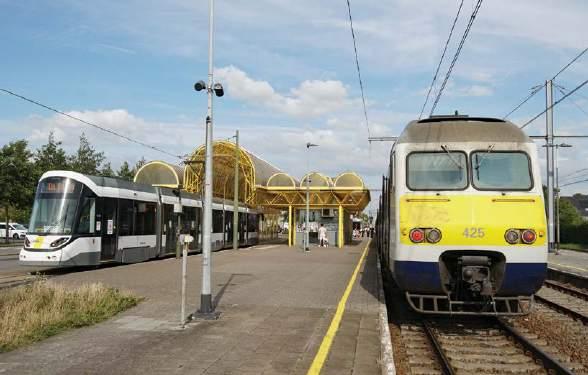

known by the French name, Bruges. At the western end of this road and railway axis, Oostende is the biggest single coastal community with around 75 000 residents, and is the centre of Kusttram operations.
The anglicised name of Ostend relates to its historic but now ended role as a ferry port.
The city’s own tram services lasted from 1885 until 1958, with some route used by today’s Kusttram. Oostende tramway’s Nieuwpoortse Steenweg site, away from revenue tracks, was upgraded and became the principal Kusttram depot and works. De Lijn’s Slijkensesteenweg tram and bus facility in a former dock area opened in 2017. Stock is also stabled near Knokke station, and there is a combined tram and bus compound near De Panne Station.
Kusttram evolved from a combination of several local railways, some using electric power from the outset. Affected by being sited in militarily crucial areas during two world wars, the service’s history also includes peacetime threats of closure, operational changes and altered alignments. Stops have been deleted, added, re-sited, renamed and improved through the 21st Century. The system’s high proportion of dedicated rights of way, mainly between carriageways or on town streets, is compromised in safety terms by behaviour at intersections. Despite
Now the sole Kusttram type, the uni-directional, low-floor CAF Urbos 100 follows a tradition of giving classes a local reference name, gaining the ‘Zeelijner name by public vote. Assembled in CAF’s factory in Zaragoza, Spain, the first of 48 (6111-6158) was delivered in June 2020 via Zeebrugge port, with the last entering service in early 2022. Part of the same De l ijn order for up to 146 vehicles, the Antwerpen (uni-directional) and g ent (bi-directional) systems have also received Urbos 100 Air-conditioned, they have five sections and are 31.4 metres long and 2.4 metres wide. Capacity is 187, of which the 54 seats include tip-up seats in the open floor areas. unlike the bN l RVs, Zeelijner does not have Kusttram branding. Full and partial advertising wraps are carried, many relating to tourist activity. bN-AC e C 6017 and 6025 have been retained for special services in the care of TTO-Noordzee. This is based at the museum depot, sited just off revenue tracks near the De Panne e splanade: for information, see: https://promottonoordzee.wixsite.com/mysite.
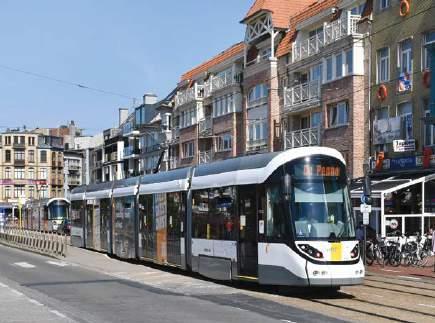
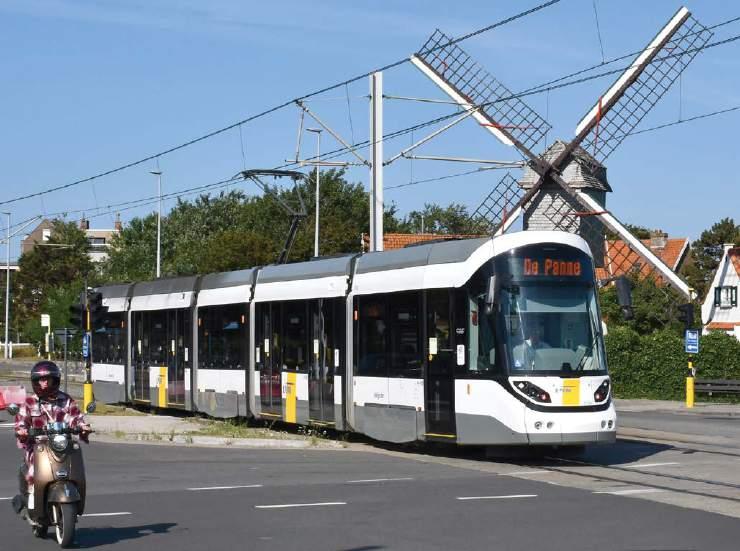
“Kusttram connects a string of municipalities between De Panne and Knokke-Heist.”
audio and visual warnings, plus tram priority, crossings have seen accidents through the years leading to temporary vehicle withdrawals and reformations, also serious injuries and fatalities.
At the end of an extension which opened in 1998, a popular Kusttram entry point is De Panne Station which offers cross-platform transfers and adjacent car parking. It is about 3km (1.9 miles) inland from the seafront in Adinkerke, a village dominated by the large Plopsaland theme park which has a designated tram stop.
Although an hourly train service connects De Panne and Veurne, restoring light rail to that town has been considered. However, there appear to be no active projects for Kusttram expansion.
Railway interchanges are also at Knokke, Blankenberge and Zeebrugge, the last being the least convenient due to the station’s siting and distance from Strandwijk stop. Here, as at other locations where a stop has a main road site, the wait for signalled safe access to platforms can be lengthy. Zeebrugge is a major cargo port, with docks reaching well inland. Two lock chambers have tram crossings at both ends whereby Kusttram services can be routed to avoid whichever lock gate is open during ship movements; Ostend has a similar arrangement.
A change of route north of Nieuwpoort completed in 2019 saw a dog-leg layout with stops in
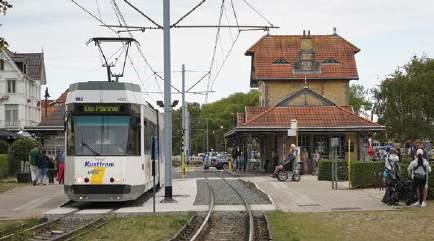
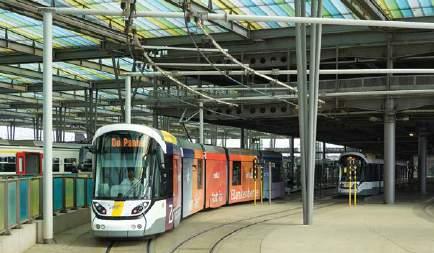
Lombardsijde village closed down.
It was replaced by a more direct route including a new stop, Lombardsijde Schoolstraat, sited between the N34 road carriageways.
A recent major scheme was Kusttram’s integration with Oostende station’s reconstruction. This terminus originally supported maritime activities, but became the city’s principal station in 1946. Gaining coastal tram coverage in 1954, it is the best-served of the Kusttram railway interchanges. Using a nearby freestanding structure between 1988 and 2019, Kusttram now has platforms under the station’s roof span.
The project included a turning circuit, replacing a more distant return loop around streets which was abandoned along with an adjoining stabling area. The station’s tram area has a Lijnwinkel, De Lijn’s term for its staffed information points, this being a year-round facility as opposed to its seasonal and mobile outlets.
Since July 2023, Kusttram has been designated as line KT, replacing the previous 0 (zero). Although used in timetables and signage, the identity is not shown on tram destination displays. Kusttram services which run the complete length between termini at Knokke and De Panne stations take
Opened: 1885 (electric sections from 1897)
Lines: 1
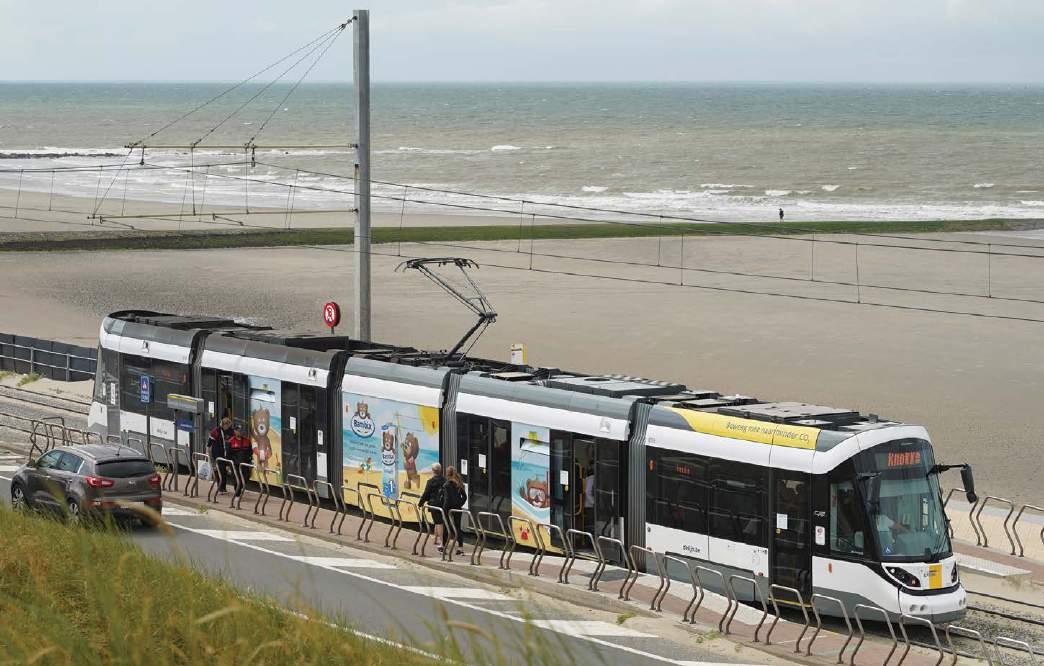
d epots: 1 depot/works + 3 support sites
Approx. weekday hours: 05.00-23.30
Line frequency (summer): 10-15 minutes
Gauge: 1000mm
Power: 600V dc, overhead supply
Fleet: 48
Network/operator: Vlaamse
Vervoermaatschappij De l ijn www.delijn.be
c ivic information: www.oost-vlaanderen.be
Tourist information: www.visitflanders.com

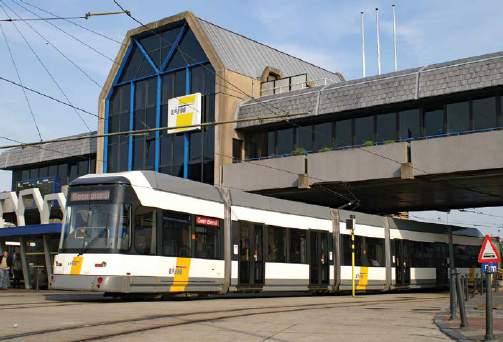
“Kusttram has been designated as line Kt, replacing the previous 0. services which run the complete length take just under 2.5 hours.”

KNOKKE
HEIST
ZEEBRUGGE
Heist Duinbergen Kerk
Willemspark
Zeebrugge Zeeluis
Kerk
Pier
BLANKENBERGE
Blankenberge Markt
WENDUINE DE HAAN
De Haan Zwarte Kiezel
BREDENE
OOSTENDE
MARIAKERKE
RAVERSIJDE
KNOKKE-HEIST
Knokke Station
Heldenplein
Heist Dijk
Stationswijk
Zeebrugge Strandwijk
Blankenberge Duinse Polders
Blankenberge Station
Maritieme Zone
Wenduine Harendijke
Manitoba
Wenduine Centrum
Wenduine Molen
Wenduine Konijnenpad
Waterkasteellaan
De Haan Aan Zee
Zeepreventorium
De Haan Vosseslag
Bredene Renbaan
Campings
BREDENE
Bredene Duinenplein
Oostende Oosteroever Vismijn
Oostende Station

DAMME
OUDENBURG
Marie-Joséplein
Koninginnelaan
Renbaan
Northlaan Mariakerke Bad
Raversijde Middenlaan
Middelkerke De Greefplein
MIDDELKERKE
Middelkerke Krokodiel
WESTENDE
Oostende Duinenkerkje
Raversijde Provinciedomein
Casino
Verhaeghelaan
Westende Bellevue
Westende Bad
Westende Sint-Laureins
Lombardsijde Zeelaan
LOMBARDSIJDE
NIEUWPOORT
Victorlaan Nieuwpoort Bad
GISTEL
Lombardsijde Schoolstraat
NIEUWPOORT
Nieuwpoort Stad
Cardijnlaan
Nieuwpoort Sint-Bernardusplein
Oostduinkerke Groenendijk
Duinpark Bad
Oostduinkerke Schipgat
Koksijde Lejeunelaan
Koksijde Bad
Ster der Zee
De Panne Canadezenplein
De Panne Centrum
Koksijde Sint-Idesbald
Moeder Lambic
Plopsaland
ADINKERKE
BRUGGE
Esplanade Kerk
De Panne Station
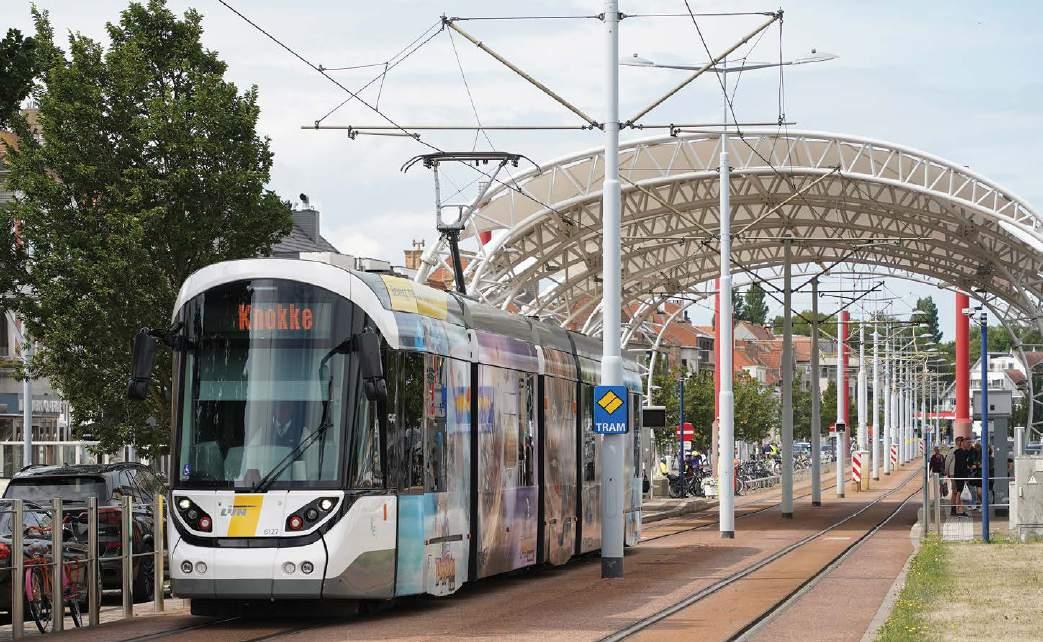
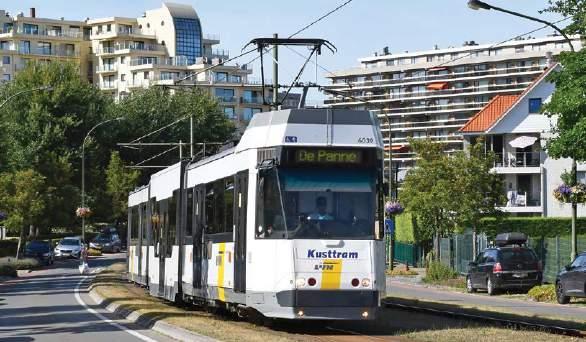
just under 2.5 hours, with a normal summer interval of ten minutes.
The loops at Oostende Station and Westende Bad are used for extra trams to double coverage along the core tourism area, which includes the almost 5km (2.9 miles) of beach-front section on Zeedijk between Oostende and Middelkerke.
The system’s coverage of different municipalities with common features such as Kerk (church), Bad (resort/spa) and Station accounts for some names being replicated. Small stop signs may just show that name, whereas larger counterparts add the municipality name. In July 2023, 12 stops had name amendments to account for changes in the surrounding area.
Saturday 23 September saw withdrawal of the type that had
dominated services since a 1981 debut. NMVB ordered two versions of these originally six-axle light rail vehicles (LRV) supplied by BN of Brugge and ACEC of Charleroi in 1978.
Unlike the 6100-series bi-directional Charleroi Metro version, the 6000-series uni-directional Kusttram stock received substantial changes, including an added low-floor centre car, revised use of space, a rebuilt driving cab-end and a livery change from orange and cream to De Lijn’s mainly white and grey.
Down to 12 examples by summer 2023, the original 49-strong 6000-series had for some years been supplemented during the summer by trams from the Antwerpen and Gent systems.
local travel: Covering all its services, De l ijn’s website (www.delijn.be) can be daunting, but it is well signposted and includes an e nglish language version. Kusttram sections include a line diagram, timetables, service status and useful navigation of the ticketing options. All cross-mode, single tickets valid for 60 minutes with transfers allowed from eu R2.50; ten-journey ticket for eu R17.00. given the system’s scale and proximity to other De l ijn tramways on which it is also valid, the Day Ticket (24 hours from validation) at eu R7.50 or 72 hours for eu R15.00 are excellent value – the ticket does not, however, include rail fares between the systems. Tickets from machines or l ijnwinkels must be validated on boarding; also online and payment by card options (prices as October 2023).
What is there to see? The coastal strip is more varied than walls of apartment blocks – visible from a great distance –may suggest. i n places the inland side of Kusttram has open countryside, with dunes and polders (small lakes) fringing the seaward side. There are nature areas protected from urban encroachment. Far from homogenous, communities along the line have distinct characteristics. i ncluding a 1930s pier, blankenberge is an overtly mass-appeal resort, with artistically inclined Knokke-Heist and elegant (away from the coastal defence seafront) De Haan comparatively restrained. On an inland Kusttram deviation, Nieuwpoort has seafront and riverside walks, with some classic Flemish architecture in the centre. Next to the tracks just north of Nieuwpoort, memorials with a visitor centre are where intentional flooding in 1914 defined the seaward end of the World War One Western Front.
ARGENTINA
LA PLATA. A 3.4km (2.1-mile) extension of the 1676mmgauge General Roca line Tren Universitario opened on 19 September. It links Policlinico and Hospital San Juan de Dios. The original 4.6km (2.9-mile) line opened in April 2013 and is worked by three ex-Portuguese NOHAB diesel railcars. RGI
AUSTRALIA
SYDNEY. CAF Urbos 100 trams 2125-28 were delivered in June but had still not entered service by the end of September. NSWtrains
AUSTRIA
WIEN (Vienna). Line 71 has been extended from Börse to Schottenring after the withdrawal of Line U2Z on 31 July. Delivery of Alstom Flexity class D trams was expected to reach number 369 by the end of November.
tramwayforum.at
BANGLADESH
DHAKA. The metro’s 8.5km (5.3-mile) southern extension from Agargaon to Motijheel (via the University) opened on 29 October. urbanrail.net
BELGIUM
ANTWERPEN (Antwerp).
The first of 18 double-ended CAF trams (7441) was delivered on 12 October. They will enter service on Line 12, replacing the increasingly unreliable ex-Gent double-ended PCCs. DS, T-2000 BRUXELLES (Brussels). Work to convert the north-south axis tram tunnel into a metro line will resume, but it will not open until at least 2030. Plans to extend the new Line 10 to Hôpital Militaire (due to open in 2024) south from Gare to Nord to Churchill have been made. This will replace Line 3. The new tramline linking Rogier and Brussels Airport is to become Line 12, but passenger service is not expected until late 2029 lecho.be, T-2000 DE PANNE – KNOKKE. Withdrawn BN tram 6017 has been handed over to the TTO group as a museum piece. T-2000 GENT (Ghent). Trams on Line 4 returned to Moscou terminus from 1 October. T-2000 LIEGE. The first test run on the new line to Coronmeuse terminus took place on 10 October using CAF tram 5101. DS
BRAZIL
BELO HORIZONTE. Alstom has been awarded a contract to re-signal and automate the
28.1km (17.4-mile) Metro Line 1 as well as the 1.6km (one-mile) extension to Novo Eldorado (due to open in 2026). RGI RIO DE JANEIRO. The state council has approved the next stage in the modernisation of the 1100mm-gauge Carioca heritage tramway. This includes re-opening the line from Dois Irmaos to Silvestre plus the branch from Largo dos Guimarães to Largo das Neves. SV
CANADA
EDMONTON. Testing on the Valley Line tramway resumed on 12 September following the completion of remedial work on the infrastructure. The line is due to open on 4 November. ETS OTTAWA. The Trillium diesel light rail line will not re-open until April 2024. It has been closed since 2020 to undergo major expansion work. Ottawa Citizen TORONTO. The second of a new batch of 60 Alstom trams – car 4605 – was delivered on 12 October and one more is expected to arrive before the end of 2023. In 2024, 20 are due, with 20 more in 2025 and the remainder in 2026. None have yet entered service.
It has been suggested that the Eglinton Crosstown light rail line might open in December 2024. It has taken over 11 years to build. The 24 July derailment that led to the closure of the Scarborough RT Line was caused by broken or loose reaction rail anchor bolts. D. Drum, CBC
CHINA
CHENGDU. Metro Line 17 was reduced to a three-station section (Jitouqiao – Jiujiang Bei) from 22 September. Jiujiang Bei to Jinxing is now Line 19.
skyscrapercity
HARBIN. The 3.4km (2.1-mile) extension of Metro Line 3 from Taipingqiao to Zhonghua Baluoke Jiequ opened on 29 September. It features three new stations. urbanrail.net
SHENYANG. Metro Line 2 was extended south by 14.2km (8.8 miles) from Quanyun Lu to Taoxian Jichang on 29 September. On the same date, the new 34km (21.1-mile) Line 4 that links Zhengxin Lu and Chuangxin Lu was inaugurated. The southern terminus provides interchange with the Hunnan tramway Lines 1, 3, 4 and 6. urbanrail.net
CYPRUS
GENERAL. The government has announced extensive improvements to public transport

infrastructure through an award of a 15-year EUR61.7m contract to the consortium AS Aircontrol Ltd/AMCO A.B.E.E. The mayor of Nicosia has said it is necessary to start the study process for tramway lines in Nicosia and Limassol.
skyscrapercity
PLZE Ň (Pilsen). The arrival of Škoda 40T low-floor trams 390 and 391 has ended use of coupled sets of Tatra T3Rs . Some highfloor T3Rs will run with partially low-floor T3R.PLFs until 2025. Other T3Rs have been sent to Ukraine. BS
DENMARK
KØBENHAVN (Copenhagen).
There are three bidders for the contract for 226 new automated S-tog cars: Alstom, CAF and a Siemens/Stadler consortium. TP
FINLAND
HELSINKI. An ‘invitation to participate’ has been issued as part of the procurement of 63 new trams. IRJ
TAMPERE. A consortium has been appointed to develop tramway extension proposals, including a 9.3km (5.8-mile) city centre – Suuppa line, and a 4.3km (2.7-mile) extension beyond Kaupin Kampus. RGI TURKU. The city council approved plans for a EUR344m tramway from Satama to Varissuo on 2 October. The 12km (7.4-mile) line is to be built in 2026-31. RGI
FRANCE
MARSEILLE. Alstom delivered the first of 48 new four-car automated metro sets in September. Three trains are expected to enter service in early 2024. T-2000 NICE. The city is to go ahead with the 7.6km (4.7-mile) Line T5 from Palais des Arts et de la Culture
to Mairie-de-Drap. It is due to be completed in 2028.
PARIS. Line P has become the first part of the Paris Transilien commuter rail network to be allocated an operator through competitive tender. Paris transit authority Ile-de-France Mobilités awarded the seven-year contract to a consortium formed by Keolis and SNCF Voyageurs on 12 October. The consortium will take over operation of the Esbly – Crécy section of Line P in March 2025. The deal also included tram-train Lines T4 and T11.
STRASBOURG. Work has started on the 4km (2.5-mile) Tram Ouest project to extend Line F from Comtes to Wolfsheim by the end of 2025. lineoz.net
GERMANY
BAD SCHANDAU. The tramway will be closed from 1 November to 22 December to allow fibre-optic cables to be laid in Kirnitzschtalstrasse. DS
BERLIN. Trams returned to Treskowallee from 4 September after completion of track relaying. The first Stadler JK23 U-Bahn set was delivered to Grünewald works on the night of 4-5 October.
BIELEFELD. All the Stadtbahn-M trams have been scrapped except 544 and 555. The former is likely to be preserved while 555 is being retained until a new Windhoff works car is delivered. BS
BONN. Škoda tram 2251 was delivered on the night of 10-11 October. SWB
BRANDENBURG. The Niederbarnimer Eisenbahn has launched a free rail service to and from the Tesla Gigafactory. The service links Erkner and Fangschleuse Tesla Süd with 28 trains per day. BS
COTTBUS. Lines 3 and 4 returned to Strasse der Jugend from 2 September after completion of infrastructure work. BS
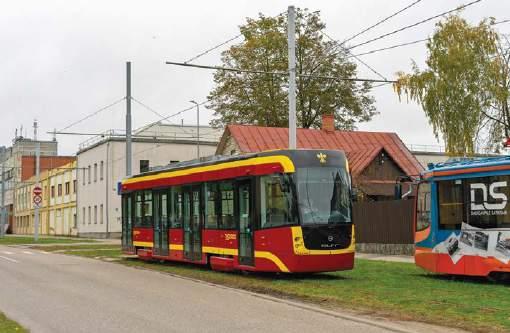
DARMSTADT. Passenger trials of the first Stadler TINA low-floor trams started on 9 October. Six SB9 trailers are being refurbished by Talbot Services GmbH at Aachen.
The re-opening of Frankfurter Strasse from 4 September has led to route changes: 1 Hbf –Eberstadt; 2 Hbf – Lichtwiese; 3 Lichtenbergschule – Hbf; 4 Kranichstein – Hbf; 5 Kranichstein – Böllenfalltor; 6 Alsbach – Arheiligen; 7 Eberstadt – Lichtenbergschule. BS
DRESDEN. The first doubleended Alstom NGTDXDD trams to be delivered were 2981 and 2982. Car 2891 entered passenger service on Line 2 on 5 October. BS
DUISBURG . The unique double-ended and ten-axle tram 1000, built in 1966 as single-ended six-axle car 60, has been withdrawn. BS
DÜSSELDORF. Seven out of 21 potential tramway extensions have been adopted for implementation: Line 705 to Nachbarschaftspark in Lierenfeld; Line 707 from Medienhafen to Hamm; Line U79 from Südpark to Universität West; Stadtbahn link from Benrath to Garath; Stadtbahn link from Holthausen to Hassels; Lines 704 and 707 with route exchange north of Schloss Jägerhof with a new link between the two termini; extension of the Wehrhahn line south from Bilker Bhf. BS
ESSEN. Metre-gauge Line 108 is now being used by low-floor trams. The city celebrated 130 years of tram operations over the summer. Historic tram 1753, built in 1962, worked a tour that included Line 108’s terminus at Bredeney. BS
HAMBURG. A special trip to mark the end of the last DT3 U-Bahn sets ran on 15 October. They were withdrawn from service in August after 55 years. BS
HEIDELBERG (RNV). The existing depot will be demolished
towards the end of 2025. Work to build a two-storey replacement will start in 2026. The new building will accommodate 32 trams on the ground floor while the upper level will handle buses and service vehicles. BS
JENA. Stadler Tramlink vehicles 801-03/05-08 had arrived by the end of September. DS
KASSEL. 1990-built 452, Kassel’s first low-floor tram, has moved to a fire brigade training ground in Mündener Strasse. BS
KREFELD. The last four Stadtbahn-M cars (838/42/4/5) have been refurbished to work alongside 30 low-floor trams. BS
LEIPZIG. The prototype HeiterBlick Leoliner 1301 has emerged from the workshops as driver-training car 5004. BS
MAINZ. New tenders have been issued for 22 new trams (with an option for eight more) for delivery from 2026. DS
MANNHEIM (RNV). Škoda 36T trams were moved to Line 2 after the national garden show finished in October.
The first 40m Škoda 37T, 1501, is being tested, including being coupled to a 30m 36T car. The municipal council approved an order for 34 more Škoda trams on 24 October. DS
OBERHAUSEN. Six 1996 Duewag trams – 205-210 – are being refurbished by IFTEC Leipzig. BS
WÜRZBURG. A new timetable from 12 September featured improved headways but required every operational tram at peak times. This included seven classic Duewag trams. BS
INDIA
BENGALURU (Bangalore).
The Purple Line metro expanded on 9 October, by 2.8km (1.7 miles) from Baiyappanahalli to Krishnarajapura and by 2km (1.2 miles) from Kengeri to Challaghatta. urbanrail.net

IRAN
TEHRAN. Extensions to Metro Lines 6 (Shahid Sattar I –Kouhsar) and 7 (Shahid Dadman to Meydan-e Ketab) opened on 10 October. urbanrail.net
ITALY
GENOVA (Genoa). The government has allocated EUR74.5m towards the cost of extending the metro from Brignole to Piazza Martinez and Canepari to Rivarolo. RGI
ROMA. Line 8 services resumed from 1 October after the completion of track relaying and other work. ecodallecitta.it
TORINO (Turin). A EUR362m grant has helped finance the 5.5km (3.4-mile) Line 12 extension to Juventus Allianz stadium as well as safety improvements on the Metro. RGI
JAPAN
HIROSHIMA . The southern arms of Lines 3 and 7 have been switched; Line 3 now only operates at peak periods. Two of three 1958-built trams – 351 and 353 –have been scrapped. Car 352 is still in service. The 1.3km (0.8-mile) Sky Rail monorail, built in 1998, is to close from 30 April 2024. It will be replaced by an electric bus, which is cheaper to operate. BS TOKYO. Japan’s first monorail, which opened in 1957 at Ueno Zoo, is being demolished. It closed in November 2019. BS
LATVIA
DAUGAVPILS. The government is funding EUR2.4m worth of tramway infrastructure improvements in order to reduce disruption. Depot repairs forced the closure of the system between 2-16 October.
The first two new trams – 021 and 022 – from the local DLRR factory (a locally assembled Czech Alliance TW EVO-1) were delivered on 17 October. J. Carpenter
AMSTERDAM. Lines 14/24 are to be cut back to Muiderpoortstation and Frederiksplein on 8 December. A blanket 30km/h (18mph) speed limit will apply across the city. The Uithoorn extension will open on 21 July 2024. OR
DEN HAAG (The Hague). The Line 19 extension to TU Delft is unlikely to meet its targeted first quarter 2024 opening date after it was discovered that concrete on the tram/bus reservation did not meet specification. OR
NIGERIA
LAGOS. Diesel push-pull operation ended on the Blue Line metro on 16 October. Full use of the EMU fleet has started, with services increasing from 12 to 54 in each direction. Skyscrapercity
PAKISTAN
ISLAMABAD. Talks have been held with Chinese consultants to discuss a possible light rail system. The length could be anywhere from 10.4km (6.4 miles) to 30.5km (19 miles). RGI
POLAND
KRAKOW. The last of 60 of 110 new Stadler Lajkonik cars was delivered on 18 October. These low-floor trams (70145, 825-89) have displaced Konstal 105N bogie trams from Nowa Huta depot. cs-dopravak
LODZ. The first two 1996 vintage AEG/MAN low-floor trams acquired from the German city of Jena were delivered on 1 October. Eight more will follow. UTM OLSZTYN. The 5.9km (3.1-mile) tramline from Skwer Wakara to Pieczewo will open on 1 January. urbanrail.net
POZNAN. MPK has signed a contract with SPS Falkone for the refurbishment of the prototype Solaris Tramino low-floor tram. Built in 2010, it has not been used since 2018. cs-dopravak
The first Czech EVO-1 tram for the Latvian city of Daugavpils was assembled in the local railway workshops DLRR. C. Grambergs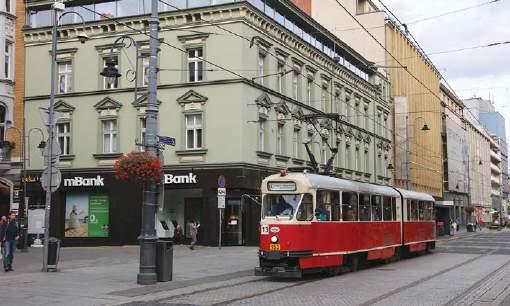
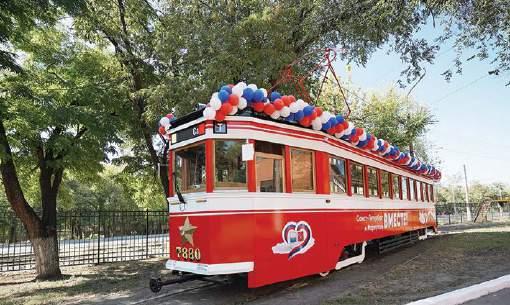
SZCZECIN. The first of two more double-ended Modertrans Moderus Beta trams (625/626) was delivered on 9 October. It will be fitted out in the tramway’s own workshop. TP
WARSZAWA (Warsaw). A contract has been placed for a 1.6km (one-mile) tramway extension to Zachodnia railway station. It includes a 500m subway. RGI
PORTUGAL
LISBOA (Lisbon). Space is so short at Santo Amaro depot after the delivery of 15 new CAF trams that 13 two-axle trams – plus 1995 Siemens articulated tram 506 – are now stored on temporary track at Miraflores bus garage. BS
PORTO. A consortium formed by ACA, FCC Construction and Contratas y Ventas has been awarded the EUR379.5m contract to build the 6.4km (four-mile) Ruby light rail line. Work should start in early 2024. IRJ
ROMANIA
ORADEA. Tenders have been invited for nine new trams (three double-ended) with the option of buying 16 more. TP
RUSSIA
CHELYABINSK. An order has been placed with UKVZ (Ust Katav) for 11 100% low-floor 71628 bogie trams for delivery by 31 May 2024. Contract price is RUR814m (EUR8.2m). RGI MAGNITOGORSK. UKVZ (Ust-Katav) delivered 71-628 bogie trams 3234 and 3235 on 11 October. transphoto.org
SANKT PETERBURG (Saint Petersburg). There was a parade of museum trams on 1 October to mark 116 years of tramway operation. The first 71-431 Dostoevsky has been renumbered 3100. A Belkommunmash T811 low-floor bogie tram arrived from Minsk on 27 September for demonstration purposes. An order has been placed with
Uraltransmash for 12 two-section 71-421 Dovlatov trams with retro styling. transphoto.org
VOLGOGRAD. Elektrotransport Plus, commissioned to modernise the city’s tram system, has ordered 50 single-ended 71-911EM Lyonok bogie trams from PKTS, plus 12 71-932 Nevsky three-section double-ended cars. transphoto.org
YEKATERINBURG. The city plans to have 80 new trams, 50 new trolleybuses and 60 new gas buses in service by 2027. Trials started on the new 4.7km (2.9-mile) line to Akademiceski on 6 September. The Verkhniaya Pyshma interurban tramway was closed over the summer to allow a connection to a new depot to be laid. transphoto.org
SEOUL. Test running on the 28km (17-mile) Line A Great Train Express commuter rail service started on 21 September. HyundaiRotem has supplied 20 eight-car trains. RGI
MADRID. A scooter battery exploded on a Line 2 train at Elipa on 17 October. It damaged car M-3636 and interrupted services for three hours. Metro Madrid may now ban electric scooters on its system. RGI
Tenders have been invited for 80 new metro trains to serve planned extensions to the network. The Spanish capital’s Line 3 will be extended to make a connection with Line 12, while Line 5 is to be extended to reach Barajas airport. Meanwhile, Line 11 will be extended by 6.3km (3.9 miles) from Plaza Elíptica towards Conde de Casal. Approval of the Madrid Nuevo Norte urban regeneration project will also require an extension to the metro system.
The new order is likely to be split: 40 new units will be for the lines with restricted loading gauge (dubbed ‘narrow profile’),
while the remainder will be for the city’s larger loading gauge (dubbed ‘wide’ profile) lines. MALAGA. The extension of the tram subway to the city centre in March has created such demand that four more
CAF Urbos 100 cars have been put into service to cope.
The Junta de Andalucía has approved the Metropolitan Transport Plan for the Malaga area, including extension of the Metro (underground tramway) eastwards to the El Palo district, creating a new Line 3. The Line 2 extension to the Hospital Civil remains on course. metromalaga.es, G. Pratt
SWITZERLAND
BASEL. Flexity 5005 and 5034 have been fitted with three different seat designs in one section. The public can vote for the one they prefer. DS
BERN. On 2 October, 913 became the first 42.5m Stadler Tramlink to enter passenger service. It ran on Line 8. Regular service with eight cars on Line 7 started on 1 November. Eleven withdrawn 1989 Duewag/Vevey Be4/8s are being donated to Lviv, Ukraine. DS
OENSINGEN – BALSTHAL (OeBB). Newly-overhauled ‘Red Arrow’ RCe2/4 607 of 1938 ran in passenger service on 4 October to mark the 80th anniversary of the line’s electrification.
Spurnullfreunde Wiesental
ZERMATT – GORNERGRAT (GGB). Bhe2/4 3021 returned to service on 9 September and will be used for charters and occasional extra services. PESA in Poland has refurbished the 1961-built car, including removing asbestos and applying a new dark brown ‘NostalChic’ livery. EA
ZÜRICH. Delivery of Alstom Flexity vehicles had reached car 4052 by mid-October. Three more are due by the end of 2023. BS
THAILAND
BANGKOK. MRT Purple and Red Lines fares were reduced to
a maximum of THB20 (EUR0.5) from 15 October. The result was a significant increase in patronage. skyscrapercity
UNITED KINGDOM
BIRMINGHAM. The railway bridge over New Birmingham Road, Dudley, will be replaced between 1-4 November. This will be the final bridge to be installed on West Midland Metro’s Wednesbury – Brierley Hill extension.
EDINBURGH. Night-time engineering works between 27 October and 12 November means that trams will only run between Edinburgh Airport and Haymarket. This will allow renewal of track and pointwork at York Place and Shandwick Place. Full services will run between 07.00-19.00.
MANCHESTER.Public announcements on parts of Manchester Metrolink have been made by singer Liam Gallagher. The former Oasis frontman made special recordings to help celebrate the launch of Beyond The Music, a global music conference and festival, which was held on 11-14 October.
NOTTINGHAM. Engineering work affected Nottingham Express Transit operations for two periods in October. Track was replaced on Middle Hill between 22-24 October while track was to be repaired at Cator Lane between 28 October3 November.
OSWESTRY. The UK Government’s Network North paper has proposed re-opening the mothballed railway between Oswestry and Gobowen. Pre Metro Operations, which operates the Stourbridge branch, has previously advocated re-opening this line as a light rail system.
SHEFFIELD. South Yorkshire Mayoral Combined Authority is offering a trackwork renewal contract on Sheffield Supertram worth GBP55m (EUR63m).
Work is due to start in 2024 and could last for up to eight years.
TYNESIDE. Nexus has successfully gained funding from the Government’s Bus Service Improvement Plan, to expand a free travel offer to over 1500 18-25 year olds who have lived in care across Tyne and Wear, Durham and Northumberland. The pilot scheme, which gave young people who had left local authority care a Pop smart card and Network One season ticket, was launched in October 2022, with funding from the NHS.
UKRAINE
HORLIVKA. Seven repaired Tatra T3s from the city of Mariupol have been transferred to Horlivka (also occupied by Russian forces). The small system is worked by 14 71-605 trams from the 1980s. transphoto.org
USA
BOSTON, MA. MBTA has selected a dark grey and green livery for the 37.4m seven-section Type 10 LRVs on order from CAF, after public consultation. A total of 9566 votes out of the 16 300 cast opted for this colour scheme. Two pilot cars are due for delivery in spring 2026. J. May
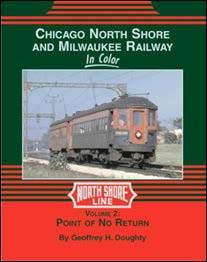
CHICAGO – SOUTH BEND
(IL/MI). The South Shore line resumed operations between Michigan City and Dune Park from 16 October. It had been closed for a year to permit infrastructure reconstruction. nwi.com
CLEVELAND, OH. The Rail Car Replacement Program has received a USD12.6m (EUR11.9m) grant from the Ohio Transit Partnership. Operator RTA has now raised USD355.3m (EUR337m) of the USD393m (EUR373m) needed to buy new Siemens LRVs. J. May MILWAUKEE, WI. The inauguration of 600m of Line L from Broadway to Lakefront took place on 29 October. It will initially only run on Sundays. S. J. Morgan
SACRAMENTO, CA. ScRT has increased its order for Siemens S700 LRVs by a further eight, bringing the total to 36. The Siemens Sacramento factory has delivered 17 so far but they will not start working on the Gold Line until next year. J. May ST LOUIS, MO. On 13 October, the Bi-State Board Operations Committee recommended that a contract be awarded to Siemens for up to 48 high-floor LRVs for MetroLink. Delivery will start from 2026. J. May


The National Trolleybus Association is selling a large collection of recently donated American electric street traction books.
The donation consists of several hundred titles collected over many years and includes books from the 1950s up to 2021 most of which are rarely seen on the European market.
For a detailed list please contact NTA Sales at ntasales@outlook.com Or phone/text 07772709563
NTA Sales, 22 Sandfield Road, St Albans, Herts, AL1 4LA, UK
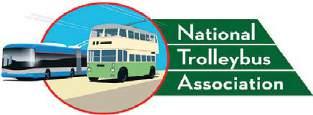

TACOMA, WA. The city is receiving five Brookville Liberty trams, not four ( TAUT 1031). Cars 2001-5 have joined Škoda 10Ts 1001-3. The headway on the recently extended line is 12 minutes (not ten minutes) Mondays to Saturdays and 20 minutes on Sundays. Trams operate 05.00-22.30 on Mondays-Fridays, 07.00-22.30 on Saturdays and 09.40-18.30 on Sundays. S. J. Morgan
TAMPA, FL. HART has received USD700 000 (EUR664 000) from the Florida Department of Transportation to permit the TECO Streetcar to remain fare-free for an additional year. In addition, USD1.75m (EUR1.6m) is available for a study of a transit link to the airport. Some 1.31m passengers were carried in the 12 months ending 30 September, a new record. Mass Transit. J. May WASHINGTON, DC. Metro service returned to normal from 2 October, although there were still some effects of a derailment at National Airport on 29 September. On 5 October Ivy Cheng was named as the millionth passenger to use Washington Dulles International Metro Station since it opened in November 2022.
R. BarrowsTOSHKENT. Metrowagonmash is to deliver 26 more Type 81 four-car metro sets in 2024 (56 are already in use). RGI
BALLARAT (AU). 1956 ex-Melbourne W7 1029, built in 1956, returned to the tramway museum on 27 September after a three-year restoration project at Bungaree workshops. It is to carry passengers during the W-class Centenary Celebrations on 18 November. BTM BARCELONA (ES). Threecar FGC set 507+809+409, built in 1944-51, has returned to service after a ten-year restoration project. UTM
BLACKPOOL (UK). Ongoing construction work has forced the closure of Rigby Road tram depot. This means that tours of the Tramtown historic collection will not resume until 2024 and limited heritage tram operations will take place until 31 December, with historic cars based at Starr Gate depot.
CRICH (UK). Storm Babet, which battered the UK in mid-October, forced the temporary closure of Crich Tramway Village. Localised flooding and a loss of power meant that its Autumn Fun week, which coincided with school holidays, did not start until 25 October.
WUPPERTAL (DE). Maffei steeple-cab tramway locomotive
608 of 1910 has returned to its home city after spending 43 years with Stern & Hafferl in Austria. It can now be seen on a short section of track at Bahnhof Loh and will be repainted into its original livery. BS
Worldwide items for inclusion should be sent to Michael Taplin at Flat 8, Roxan Villa, 33 Landguard Manor Rd, Shanklin, Isle of Wight PO37 7HZ, UK. Please fax: +44 (0)1983 862810 or e-mail miketap@mainspring.co.uk
UK and Ireland items are welcomed by the Home News Editor, John Symons, 17 Whitmore Avenue, Werrington, Stoke-on-Trent, ST9 0LW, UK. E-mail uknews@lrta.org
Acknowledgements are due to Blickpunkt Straßenbahn (BS), BTM, CBC, cs-dopravak, Drehscheibe (DS), ecodallecitta.it, Eisenbahn Amateur (EA), ETS, International Railway Journal (IRJ), lecho.be, lineoz.net, Mass Transit, NSWtrains, nwi.com, Op de Rails (OR), Ottawa Citizen, Railway Gazette International (RGI), skyscrapercity, SV, Spurnullfreunde Wiesental, SWB, Tram-2000 (T-2000), tramwayforum.at, transphoto.org, Transport Publiczny (TP), urbanrail.net, and Urban transport Magazine (UTM).

matt@mainspring.co.uk

Letters submitted by post should be clearly typed and preferably not handwritten. We reserve the right to edit contributions for publication.
I have enjoyed the recent correspondence on this subject and can only agree with much of what both Tony Young and David Holt have written. One item that I must take issue with, however, is Tony’s comment that “street running with Tyneside Metro… was quickly dismissed”.
Since the main driver for the development of the Metro was to transform the loss-making and under-used North Tyne Loop and the South Shields heavy rail lines so that they could become the backbone of a new integrated public transport system, the need for street running simply was not there initially. Access to the centres of Newcastle and Gateshead was achieved by constructing the key underground links and bridge, which was the only practical option.
It was recognised at the outset that future extensions, particularly into the heavily built-up areas to the west of Newcastle city centre, would have to be
Upon what published market research or opinion poll findings does Tony Smith (TAUT 1031) rely to make his statement “Londoners still miss their Routemasters”? Really?
All Londoners? For a start, a significant proportion of the younger population will not be aware of their existence given that the Routemasters’ final withdrawal from normal service was 18 years ago.
Mr Smith makes his comment as a resident of Canterbury, some 100km (60 miles) distant from the capital. I am a life-long Londoner and almost-daily bus user. I am not aware of any groundswell of opinion that laments the passing of the Routemaster which, compared to modern buses, had cramped seating, poor provision of luggage space and difficult access from a single rear platform which had to cope with passengers both alighting and boarding. Yes, the Routemaster was technically advanced when first introduced, but to say that it is ‘missed’ is blinkered nostalgia.
Peter Haseldine, by e-mail
An Australian viewpoint
A point regarding the editorial in October 2023’s TAUT, in which the Sydney (NSW) Metro West is cited as an example of the cost of metros justifying light rail. Construction of Metro West is well in progress, it ’s not under threat and the cost has not risen by anything like the amount claimed.
Australian cities are very large in area and there is no way in the world that light rail can substitute for metro to cover these distances,
built to light rail standards. To this effect a number of possible alignments were examined in detail, including along the West Road and Elswick Road. It was clear from this work that a much lower degree of segregation would be possible on these extensions than had been the case with the initial railway conversions, although they would have featured high platforms.
When the underground station at St James was designed, the possibility of extension to the west was specifically allowed for. Since additional rolling stock would have been required to operate these extensions, it became clear over time, as traction technology developed, that the options were becoming more straightforward and cheaper than had been assumed originally.
Tyne and Wear Metro broke the mould for the UK in a great many respects (track brakes, auto-couplers, inductive train-stops, positive train identification,
having nothing like the capacity or the commercial speeds of metro. The West Metro will cover the 22km (13.7 miles) between Sydney and Parramatta in 20 minutes. Light rail would take well over an hour.
Light rail is better for local services and, indeed, the Parramatta Light Rail Stage 2 will cover an adjacent catchment to Metro West and feed to Metro West, performing a complementary local role. Horses for courses, the way it should be.
Tony Prescott, by e-mail
Readers might be interested in some photos of testing at Wolverhampton station (right). Passengers get booted off service cars at the Royal, and the trams then run under supervision to the station. There is OHLE to the bus station stop and then it’s on batteries.
The bus station image is of an outbound tram on Pipers Row. The other shows a tram turning from Pipers Row into Railway Drive. Mike Ballinger, by e-mail
Just a personal opinion, but to me, the best looking tramcar design in the October magazine is the Philadelphia PCC car on page 402. This design, originating from the late 1930s, does not require a sunblind for the motorman. The same can be said for all tramcars in the first half of the 20th Century, whereas all modern, flashy, hoof-nosed cars have high windscreens with sunblinds in constant use.
plug doors, single bore tunnels with side walkways, automatic multivendor ticket machines and encoded through bus/ Metro/ferry ticketing, to name but a few). This kept the team responsible for the system’s design and construction pretty busy until 1984 when the final part of the initial system opened.
After a year or so of delivering everything that had been promised and more, came the 1985 Transport Act which completely changed the landscape. The integrated network was effectively destroyed quite rapidly. Looking at further extensions along main road corridors simply wasn’t on the agenda any more.
There is much more that could be said, particularly on the importance of modal integration for successful urban public transport and for light rail in particular, but I thought that it was important to set the record straight on Metro’s early days.
John Baggs, by e-mail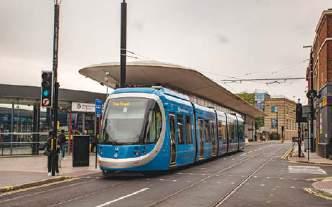
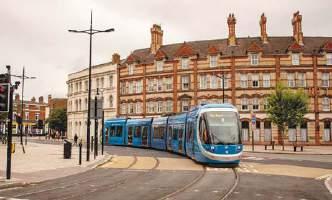
Perhaps a modern car designer can tell us the need for high windscreens? The motorman is not bird-watching or stargazing; he has to keep his eyes on the road ahead and surely it is safer to use car body designs with lower windscreens that cut out any sunglare that warrants a sunblind?
I echo the sentiments of Tony Young in last month’s Mailbox, and wonder if we shall ever learn from past experience?
Cedric Greenwood, Norfolk, UK
Mike Russell reports on remarkable and little-known tramway survivors in northeastern Scotland, UK.
This month’s article features cars to be found in a pair of properties on one campus in Aberdeenshire. The location is Alford (pronounced Afford), about 25 miles west of Aberdeen, and is not one regularly visited by tramway students on account of its relative inaccessibility. Yet the contents of these museums are full of interest.
The Grampian Transport Museum contains, among a crowded host of other vehicles, two tramcars of great antiquity –one single-deck and the other an open-top double-deck carriage. The latter is Aberdeen horse-drawn car 1, built in 1896 by local coachbuilding firm R&J Shinnie, and initially operated by the Aberdeen District Tramways Company before passing to the Corporation on municipalisation in 1898.
This car was adapted for electric traction between 1900-02 and later relegated to use as a salt car. In 1924 it was reconverted to a horse car to take part in a celebration of 50 years of tramway operation, and subsequently forgotten until resurrected for the closure of the Rosemount route in 1954, taking part in the closing ceremony on 3 May 1958.
Due to be burned at Queen’s Links along with all other surviving cars, it was saved for inclusion in a new transport museum in Edinburgh. Although not typical of the latterday fleet it is a most remarkable survivor.
The lower saloon of Aberdeen Suburban Tramways 11 is also at Alford. It has been adapted as a trailer on the 2ft- (610mm-) gauge Alford Valley Railway.
Cruden reconstruction
Alongside the horse car is a reconstruction of one of the two four-wheel cars that served the isolated hotel (the most northerly tramline in the UK) from 1899 to its closure in 1940. The hotel was built by the Great North of Scotland Railway Company (GNSR),
and the two tramcars were products of its Kittybrewster works. Electrical work was contracted to Messrs Lowdon of Dundee, which procured single-motor Peckham cantilever trucks and faceplate controllers from ECC of Wolverhampton.
The 3ft 6in- (1067mm-) gauge line, merely 1.06km (0.66 miles) in length, was powered from the hotel’s own generator, probably at 250V dc, and in addition to the two passenger cars there were a four-wheel closed van and two bogie trailers. From the outset the hotel became the central laundry for all the GNSR’s hotels and restaurants.
The line was initially profitable but moved into deficit from 1921, and in 1932 the railway to Cruden Bay was closed.
Through passengers who were hotel guests from the south were then conveyed to and from Aberdeen by two second-hand RollsRoyce limousines. The two trams continued to carry goods and laundry until December 1940 when the hotel was requisitioned by the army, whereupon they were dismantled and sold. The bodies survived locally for many years but there was no identification on either body; the car exhibited as number 2 is an amalgam of the best of the two, and the remains of the other parts remain in store.
A restoration project was started in 1988, initially under the auspices of Aberdeen City Council, in conjunction with Aberdeen Museums and the Grampian Transport museum, with sponsorship from the Heritage Lottery Fund and various local commercial bodies; work was completed in 2000.
The other tramcar is held in a building known as the Collection Centre a short distance away on the same site; this is not a ‘museum’, but the owners gladly welcome visitors. It is the shell of Aberdeen doubledeck car 15 of 1901, built by Brush/Aberdeen


Corporation as an open-top vehicle but rebuilt with an upper deck cover in 1906; this accounts for its great overall height.
Withdrawn from service in 1929 along with the remainder of the original batch of 12 cars, it initially became a summer retreat but subsequently a full-time house. In about 1950 it was internally gutted and modified.
Around 2010 a new owner presented the car to the Aberdeen & District Transport Preservation Trust, which recovered it to display in the Dundee Transport Museum. It was moved to Alford in December 2019. The long-term intention is that it should be returned to running condition and so, in addition to raising funds, the Trust has acquired a number of components. The largest of these is an ex-Porto 21E-type truck that is a good match for the type that 15 finished its days with in Aberdeen service.
In the early 1960s there was an attempt to rescue car 14 of the same batch of cars and it was accepted for future operation at Crich. As an example of the double-deck cars from this magnificent system, though, 15 is sadly destined to remain unique.
With grateful thanks to Ian Souter for the provision of additional information.
The Grampian Transport Museum is open Thursdays-Mondays 10.00-17.00 from the end of March to the end of October; admission (2023) is GBP10-12.
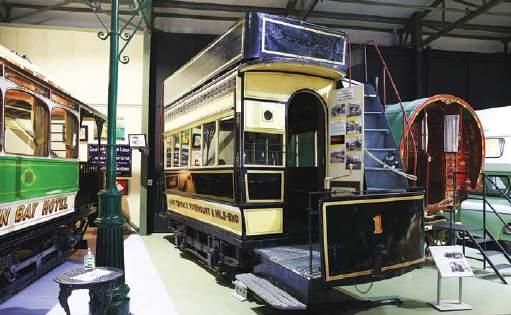
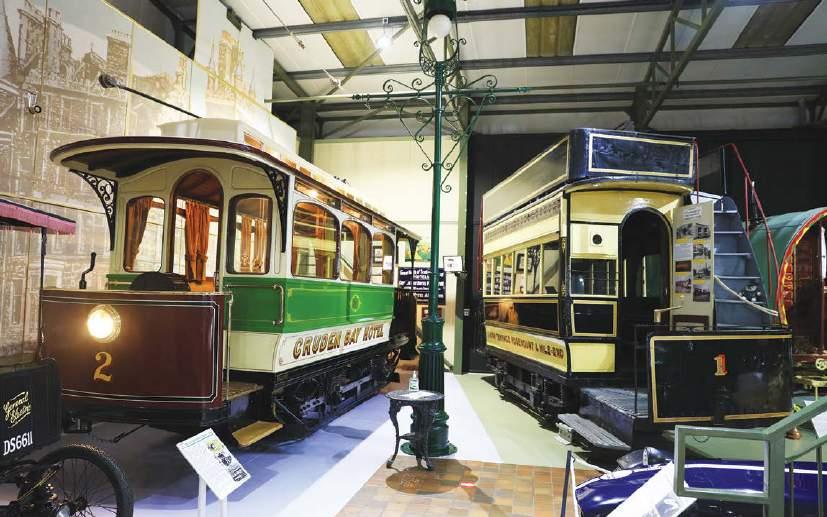
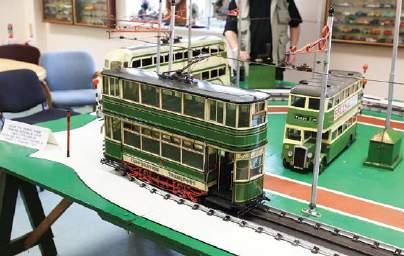
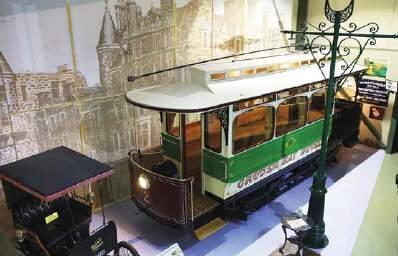
It is with sadness that we acknowledge the death on 12 July 2023, at the age of 74, of Lubomir Kysela. For 34 years he was the administrator and effectively spiritual ‘father’ of the great tram museum in Praha, which ranks as one of Europe’s finest.
Kysela joined the Praha city transport company in 1966, initially on a parttime basis whilst studying mechanical engineering, and with the exception of a period of military service, remained with it all his working life.
From 1968 he was a conductor and motorman from Pankrác depot, where he became familiar with the last surviving two-axle tramcars and worked with Josef Handl, founder of the city’s collection of historic tramcars. After the grand farewell cavalcade to the old cars in 1974, the next year brought the first great tramcar parade marking 100 years. Both events marked turning points in the rescue of Praha’s old tramcars, and he thereafter devoted his life’s work to the creation and development of the collection. He was officially appointed administrator in 1977.
A stubborn and intransigent man, Kysela knew exactly which vehicles he wanted
represented in the museum and enjoyed the right of direct access to the company’s chief executive whilst discussing conceptual aspects of the museum. His great achievements were in building up the collection and succeeding in having part of St ř ešovice depot designated as the city transport museum, opened in 1993.
He steadfastly filled gaps in the collection and changed the initial policy under which exhibits were not properly restored and painted in an inappropriate style. Under his tutelage, restoration was meticulously and regularly supervised to present vehicles in authentic condition. His work was greatly respected in the DPMP workshops at Rustonka and later at Hostiva ř.
Another great achievement was allowing the inclusion of trolleybuses and motor buses in the collection, previously excluded.
By the time of his retirement in 2009, the museum had grown to 57 exhibits.
A modest man, Kysela was always keen to emphasise the vital role played by other personnel and volunteers from the city tramway club. He retained a keen interest in the collection and continued to offer advice and guidance throughout his life.
1. The body-shell of Aberdeen Corporation car 15 is stored in the Collection Centre. This long-term restoration project will culminate in the car being returned to operational condition, using a Porto truck.
2. The well-appointed saloon of the Cruden Bay Hotel tramcar. Just visible on the rear platform is the enormous wicker linen basket.
3. A remarkable survivor: Aberdeen horse-drawn tramcar 1, built in 1896, narrowly escaped the conflagration that engulfed all other tramcars in the city fleet after closure in May 1958.
4. The reconstructed Cruden Bay Hotel car on the left and the Aberdeen open-top double-deck horse-drawn car share tramcar corner in the Grampian Transport Museum.
5. No example of an operational double-deck tramcar from Aberdeen exists. The nearest we have is a model layout of the city’s trams and motor buses built by Allan Kennedy, formerly the tramway’s Works Superintendent.
6. Car 2 of the Cruden Bay Hotel line is a reconstruction of one of its two 1899 cars, assembled from components salvaged from both bodies.
All images by Mike Russell on 7 May 2022.

He personally trained his successor as curator, Ond ř ej Láska.
Whilst Kysela was not favourably disposed to the regular operation of historic two-axle cars for public service, Praha sees this as a vital component of its museum offering, distinguishing it from many other collections. Visitors to the Czech capital today will encounter historic trams mingling with their modern successors, an achievement made possible through the work and determination of Lubomir Kysela.
Si monumentum requiris, circumspice – if you seek his memorial, look around you. MJR
4

Over 40 members attended the successful AGM weekend in Sunderland, starting with a visit to the Nexus Innovation and Training Centre. There they were able to view the new CAF vehicles, which are currently undergoing system trials.
This was followed by an evening reception at the North East Land and Sea Museum. Based on part of the former Sunderland Airport, the Museum boasts several exhibits
including a Harrier Jump Jet, Vulcan Bomber and Tornado Fighter jet, as well as several Blackpool trams and models of Sunderland and Newcastle trams.
On Saturday there was a chance to ride the Nexus system, followed by the AGM in the new Sunderland Civic Centre. During the meeting, presentations were made to Mike Willsher and John Laker for their services to the Association.
Mike Parker, former Nexus DG, was the
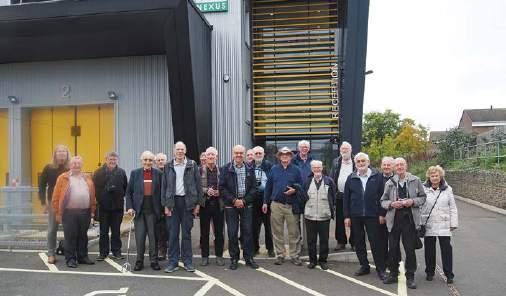

guest speaker at the evening dinner, regaling the audience with the struggle he had to secure the Sunderland Metro extension.
On Sunday members visited Beamish where there was a full steam day as well as four trams in operation.
The weekend concluded on Monday when several members journeyed to Edinburgh to ride the extension to Newhaven.
The 2024 AGM will be held in Belgium.
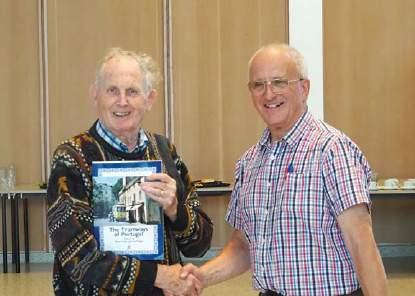
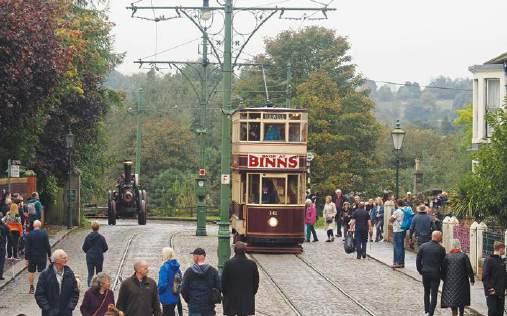
Tuesday 5. Southampton 19.30.
Steve Dungay: North American railcams. Eastleigh Railway Institute, £3. (LRTA/SEG)
Tuesday 12. Leeds 19.30. Members slides and videos. The Engine House,
Middleton Railway, Moor Road, Leeds LS10 2JG Contact: leeds@ lrta.org. £1 (inc. mince pies and light refreshments). (LRTA/LTHS)
Wednesday 13. Sussex 19.40.
Sussex Group: Christmas tram feast. Southwick Community Centre, BN42 4TE. sussex@tlrs.info. £2. (TLRS).
Compiled by the LRTA. For a full list of the year’s events and meeting places, including online meetings, visit www.lrta.org
Saturday 16. Nottingham 14.00. Tramway films. Beeston Scout Hut, NG9 1GA Contact: alo@tlrs.info. (TLRS)
Tuesday 19. London 14.30.
Mike Russell: Germany (both East and West) 50 years ago. The Model Railway Club, London, N1 9DA. £2. (LRTA)
Tuesday 2. Southampton, 19.30.
Mike Russell: A recent tour of US light rail systems and museums. Eastleigh Railway Institute, £3. (LRTA/SEG)
Events for 2024 to be released soon...

Order online from www.lrta.info/shop – or by post from:
LRTA Publications, 38 Wolseley Road, SALE, M33 7AU
(Please provide telephone contact details and quote LRTA membership number if applicable)
Outside UK = Airmail to Europe (includes all of Russia) / Surface mail to rest of world; Airmail Zone 1 = outside Europe excluding Australia, New Zealand & USA; Airmail Zones 2/3 = Australia, New Zealand & USA

This book celebrates the return to original condition of the 1931 experimental London County Council tram, telling its story from outline drawings through operation in London and Leeds, to display in the first British Transport Museum and a new life at Crich Tramway Village.
> A4 hardback; 224 pages, 330 colour and black & white pictures, four maps.
£38.50 (UK addresses); £49.50 (outside UK); £58.50 (Airmail Z1); £63.50 (Airmail Z 2/3); LRTA Members: £3.50 discount
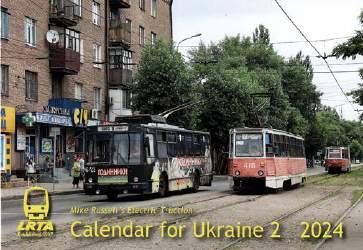

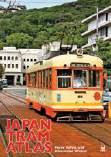
A comprehensive review of the tramways and trolleybuses of Japan with superb track maps for every system. Details of the car types operated and the routes on which they run are covered. English and German text.
> A4 softback; 272 pages, 423 colour and black & white pictures, 48 track maps.
£36.50 (UK addresses); £46.50 (outside UK); £56.50 (Airmail Z1); £61.50 (Airmail Z2/3); LRTA Members: £3.25 discount
Following the success of our first calendar aimed at raising funds for the people of Ukraine, the 2024 Mike Russell Electric Traction calendar includes a further selection of full-colour images of trams and trolleybuses at work in seventeen Ukrainian cities, together with a location map and list of world systems.
£15.00 (UK addresses); £18.50 (outside UK)
No member discount on calendars
Minimum of £5 from each sale will go to the Disasters Emergency Committee Appeal – if you’re able to donate more your help will be appreciated.
Tells the story of a truly remarkable network in a region of Poland rich in mineral resources, which has survived the risk of closure and become an important player in the regional transport infrastructure.
> A4 softback, 240 pages, 300+ black & white and colour pictures plus large-scale folding track plan.
£38.50 (UK); £45.00 (outside UK); £49.50 (Airmail Z1); £55.00 (Airmail Z2/3); LRTA Members: £3.50 discount

This new fifth edition of the popular LRTA handbook has been expanded to include the new installations in Lisboa and Porto. It also provides wider coverage of the trolleybuses, providing a comprehensive overview of electric street traction in Portugal.
> A4 softback, 328 pages, 400+ black & white and colour pictures and 57 maps.
£48.50 (UK); £55.00 (outside UK); £59.50 (Airmail Z1); £65.00 (Airmail Z2/3); LRTA Members: £4.50 discount
For further details of all these books go to our website.
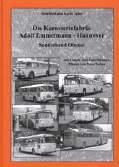
Die Karosseriefabrik Adolf Emmelmann – Hannover Sonderband Obusse
Detailed history of the 44 trolleybuses built by this German bodywork supplier on various chassis types for the cities of Hannover, Osnabrück, Hildesheim, Gießen, Moers, Kaiserslautern and Luzern. Includes facsimile specification documents, layout drawings, etc. German text.
> A4 hardback; 208 pages; 232 black & white pictures, 13 maps. £30.00 – www.nationaltrolleybusassociation.org
Boston in Transit
Mapping the History of Public Transportation in The Hub
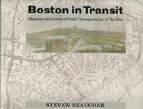
An amazing book that relates the story of this US city’s public transport system from the first ferry services of the early 1600s to the modern rail and bus system of today, through the development of large streetcar and trolleybus networks plus the nation’s first subway line.
> 285x275 mm hardback; 592 pages, 800+ black & white and colour pictures, 250+ maps. USD70.00 – www.mitpressbookstore.mit.edu / www.amazon.co.uk

Now in its 18th year, the UK’s leading light and urban rail conference, exhibition and networking event is renowned as THe place to create long-lasting relationships in our fast-moving and vibrant sector.
More information announced soon...
Register your interest in speaking, exhibiting or sponsorships at the UK Light Rail Conference by e-mailing conferences@mainspring.co.uk